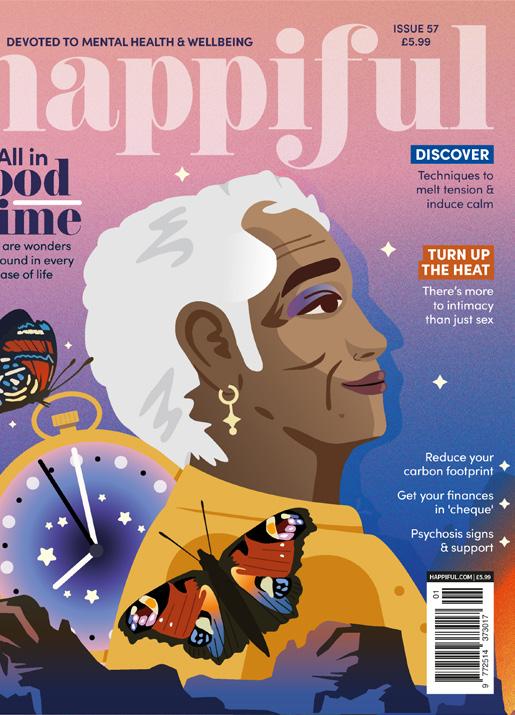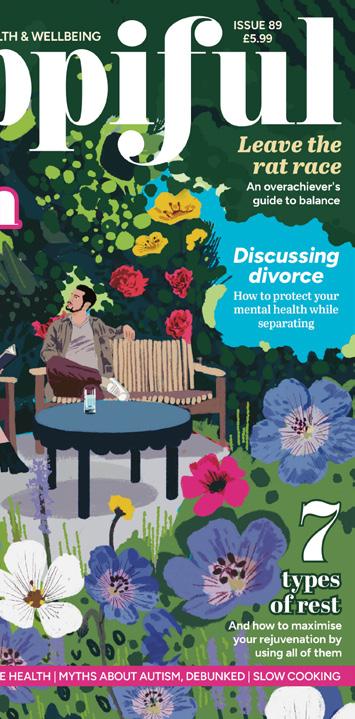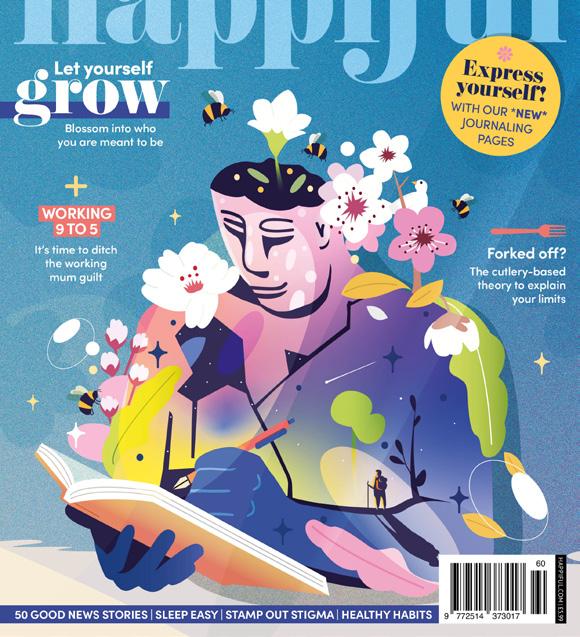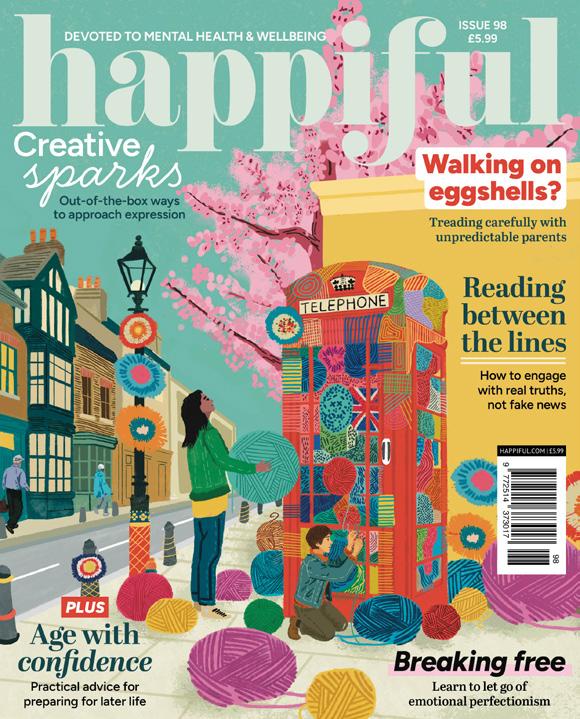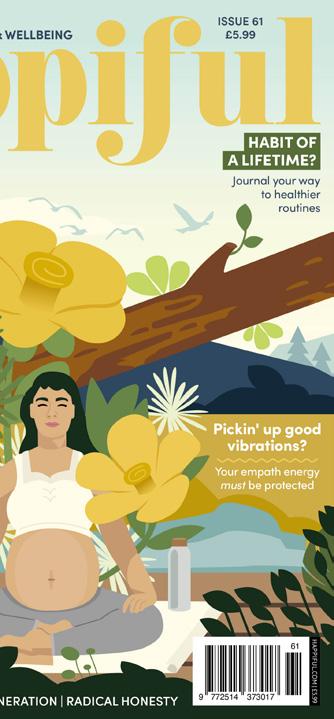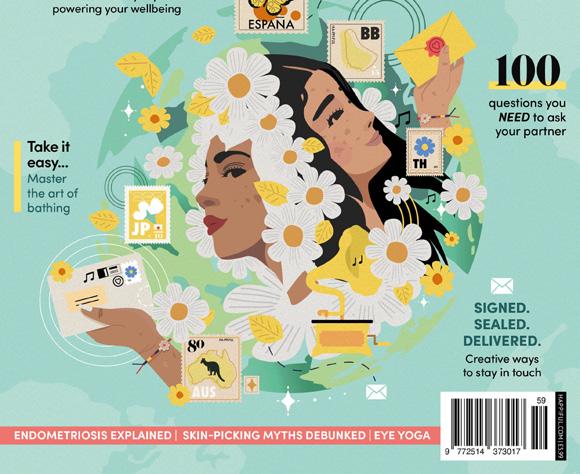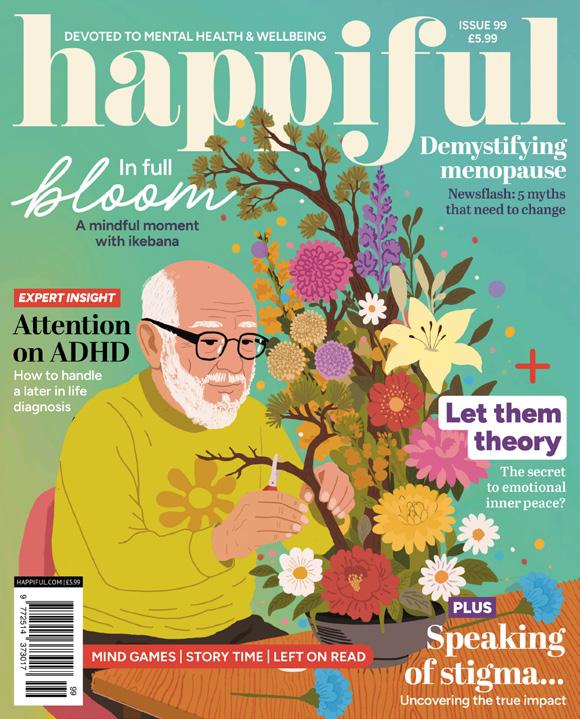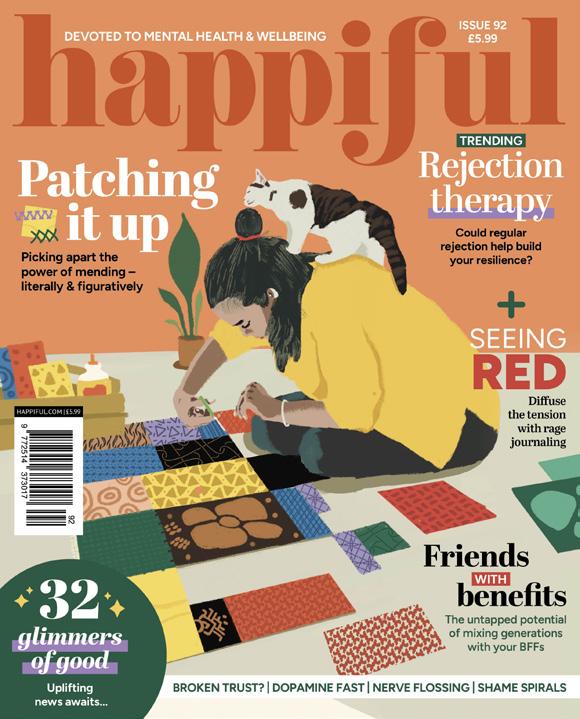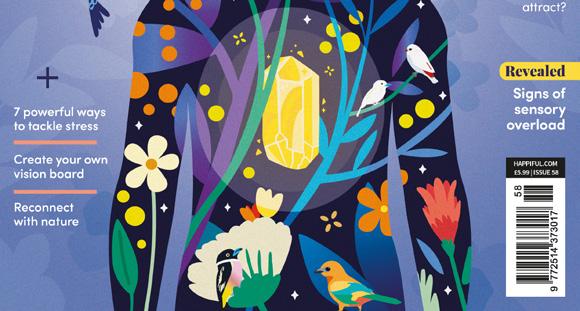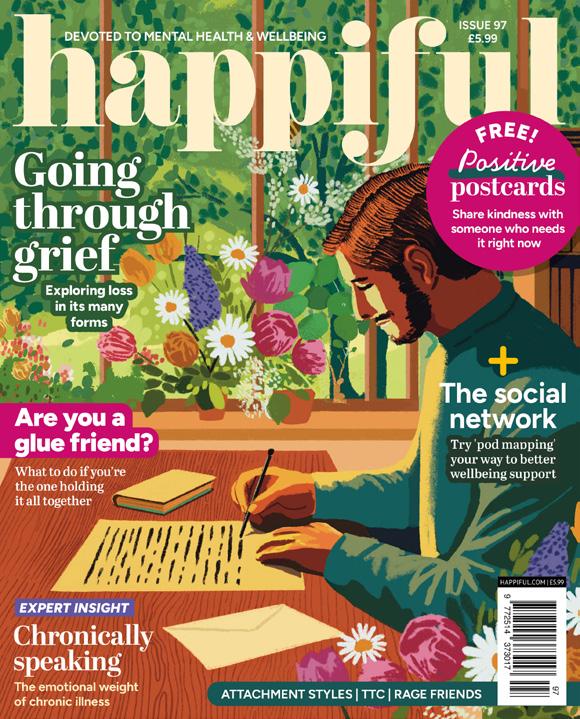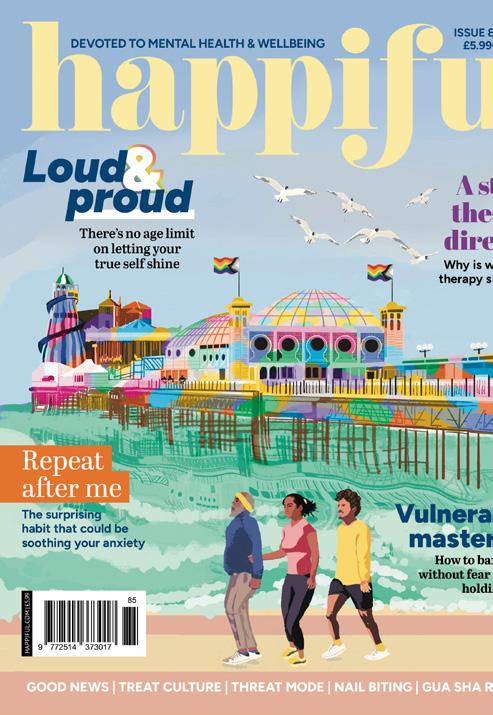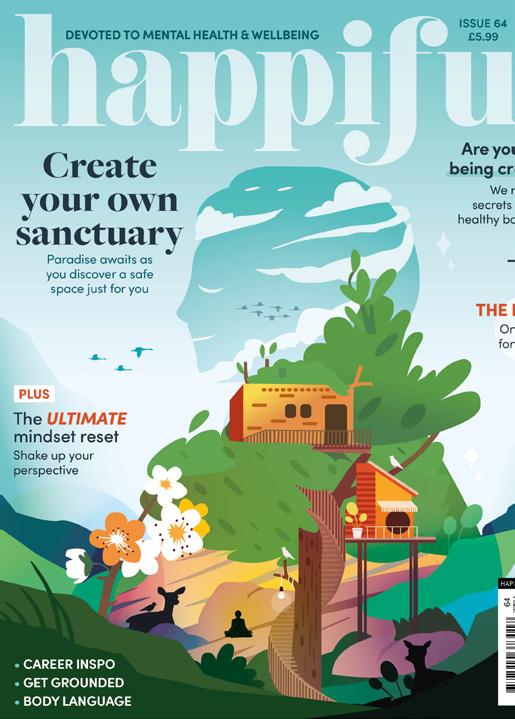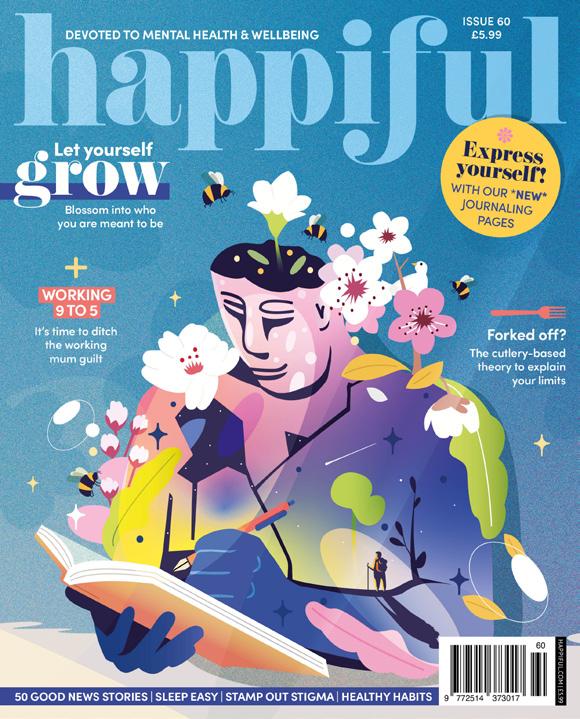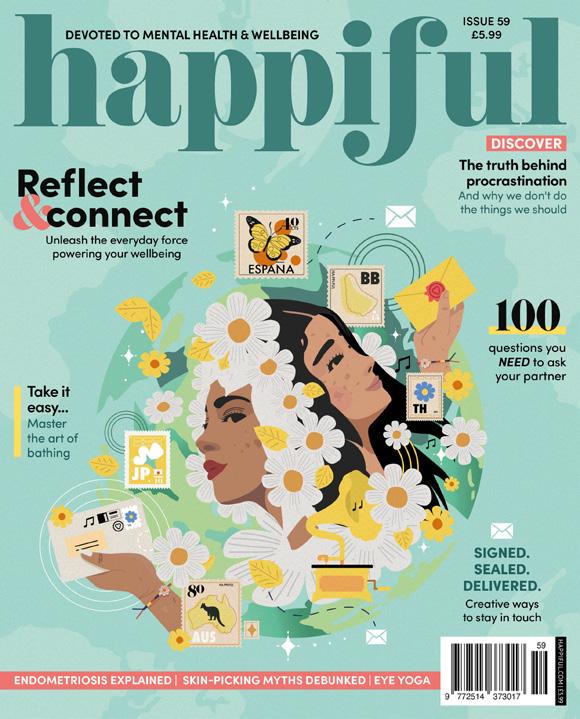
issues of Happiful magazine

Time doesn’t heal all wounds, but what you do with your time does
Mel Robbins


issues of Happiful magazine

Time doesn’t heal all wounds, but what you do with your time does
Mel Robbins
You heard it through the grapevine: Happiful has hit 100 issues! But I like to think we’re not old, just vintage – and only getting better with age.
Naturally, our 100th issue feels like a pretty special achievement, and I’m so incredibly proud of our team at Happiful for the genuine care, attention, and love poured into every edition.
I’ve been here for every single one of those issues – from starting the magazine from scratch, with six weeks until our first deadline, to anniversary editions, special themes, guest edits, and the ones where it seemed that absolutely everything that could go wrong… did.
I also remember the messages of support that always seemed to come in those moments where we needed them most, as if readers had a sixth sense with their timing. A simple comment on a Facebook post, the unexpected handwritten letter that arrived in the post, or the review detailing the difference that having Happiful to turn to has made in someone’s life.
So to thank you, our wonderful readers, this issue is a love letter to you.
It encapsulates your most requested topics in fresh and intriguing ways –such as exploring the ‘ADHD iceberg’ (p16) and the link between menopause and eating disorders (p25) – along with unparalleled expert insight on essential topics, from dealing with a dismissive doctor’s appointment (p54) to understanding the surprisingly ‘static’ side of perfectionism (p56).
Plus, as an extra special treat, we’ve carefully created a brand new booklet that seeks to be an antidote to your anxiety – 24 pages packed with guided journaling activities and articles to help you reclaim your calm.
While this seems like a perfect opportunity to reflect and celebrate, one thing I want to emphasise is that a milestone doesn’t have to be a neat round number, or something found on the front of a Hallmark card. Sometimes it’s problem-solving against the odds. Sometimes it’s knowing that no matter what happens, you have a team behind you, ready to rally and get you over the line.

Beyond being a metaphor for sending another edition off to print, I hope that feeling of support still emanates from every issue. That you, our readers, know that the team here, day in and day out, is thinking about you in everything we do.
So when you feel drained, and like you have given all you’ve got, know that the team at Happiful is your support network. Let’s turn the page together.
At Happiful, inclusivity, representation, and creating a happier, healthier society are at the forefront of our mission. To find out more about our social and environmental pledges, visit happiful.com/pledges
REBECCA THAIR | EDITOR-IN-CHIEF

W | happiful.com
F | happifulhq
X | @happifulhq
I | @happiful_magazine
T | @happiful_magazine
12 Your serve!
This ping-pong communication tool makes for winning conversations
16 Tip of the iceberg
Why ADHD is so much more than what we see on the surface
22 Cathartic complaining ‘Moaning’ in a mindful way could be just what you need 41 Steeped in calm
Lean into the mindfulness of Chinese tea ceremonies
77 Empathy skills
A masterclass in what it takes to truly understand others Relationships 33 Emotionally attached
The theory that can help strengthen bonds
Incommunicado Is it time to go ‘no contact’ with your ex?
Faces of abuse 80 Are ultimatums ever OK?
therapist explains...



28 Community corner
Meet these inspiring poolside peer support pals 30 Ask the experts Why self-compassion is essential for coping with OCD
Anxiety on your mind
Sian opens up about the pressures of living alone
56 Expert column
Counsellor Bea Appleby explores the roots of perfectionism
61 Myths, debunked Common misconceptions about panic attacks
68 Michelle Elman
Your inner child is calling; this is what they need to hear



experiencing anxiety that interferes with daily life, we’ve put together an exclusive guidebook that can help. So set aside some quiet time to gently explore angst from all angles, so you can find a path forward. Featuring reflective prompts, habit trackers, and strategies to provide an andidote to anxiety.
on your life so far, and craft the narrative you desire, with our ready-to-use journaling pages
Every issue of Happiful is reviewed by an accredited counsellor, to ensure we deliver the highest quality content while handling topics sensitively.
One of the biggest questions we can ask is: who am I? This question defines how we engage with ourselves, the world, and the meaning we take from it. Check out p74 to develop a better understanding of yourself by defining your personal values. This gentle reorientation often leads to another powerful question: who do I want to be? This question has great potential to transform you from within, and your personal values are core to this exploration as you step into the wonderful unknown.


Meet the team of experts providing information, guidance, and insight throughout this issue
NADIA DILUZIO
FdSc MBACP
Nadia is an integrative counsellor and psychotherapist specialising in workplace mental health.

FIYAZ MUGHAL OBE
MBACP
Fiyaz is a counsellor and therapist specialising in anxiety conditions and OCD.

LINDSAY GEORGE
MA Dip RGN MBACP
Lindsay is a counsellor, psychotherapist, and trained nurse.

ALI ROSS
DProf MUKCP
Ali is a psychotherapist and the founder of Caya Therapy practice in Peckham.

RUCHI BHUWANIA LOHIA
BSc (Hons) mBANT rCNHC
Ruchi is a longevity-focused registered nutritional therapist.

TINA CHUMMUN
MSc MUKCP
Tina is an accredited psychotherapist and trauma specialist.

CLARE PATTERSON
MSc DipPsych LLB MBACP
Clare is an integrative transpersonal psychotherapist and Reiki practitioner.

HELEN UNWIN
ACC
Helen is an ADHD and confidence coach focusing on self-acceptance and awareness.

BEA APPLEBY
BSc (Hons) Dip MBACP
Bea is a humanistic counsellor, working with adults and couples.


EDITORIAL
Rebecca Thair | Editor-in-Chief
Kathryn Wheeler | Features Editor
Fiona Fletcher Reid | Features Editor
Lauren Bromley-Bird | Editorial Assistant
Kat Nicholls | Brand & Integrity Manager
Bonnie Evie Gifford | Content Writer & Editor
Bea Appleby, Michelle Elman | Columnists
Ellen Lees | Head of Content
Keith Howitt | Sub-Editor
Rav Sekhon | Expert Advisor
ART & DESIGN
Charlotte Noel | Design & Commerce Manager
Rosan Magar | Illustrator & Videographer
COMMUNICATIONS
Alice Greedus | PR Manager
Emily Whitton | Content & Multimedia Editor
CONTRIBUTORS
Maxine Ali, Elizabeth Bennett, Jemma Broadstock, Caroline Butterwick, Sian Dennis, Kerry Law, Samantha Redgrave Hogg, Lydia Smith, Fiyaz Mughal OBE, Ruchi Bhuwania Lohia, Rosie Cappuccino, Luke Clark
SPECIAL THANKS
Rachel Ashe, Annelise Bennett, Tina Chummun, Nadia DiLuzio, Lindsay George, Louise Lawrence, Anna Lewandowska-Bernat, Clare Patterson, Ali Ross, Karen Sinotok, Audrey & Pauline from Mental Health Swims, Dr Lalitaa Suglani, Helen Unwin, Dr Rebecca Varrall, Laura Wood
MANAGEMENT
Amy-Jean Burns | Chief Executive Officer Claire Vince | Chief Operations Officer
SUBSCRIPTIONS
For new orders and back orders, visit shop.happiful.com, or call Newsstand on +44 (0)1227 277 248 or email subenquiries@newsstand.co.uk
DR LALITAA SUGLANI
BSc (Hons) MSc PhD MBPS MHCPC
Dr Suglani is a psychologist and coach, focusing on life, relationships, and ADHD.
CONTACT
Happiful, c/o Memiah, Building B, Riverside Way, Camberley, Surrey, GU15 3YL Email us at hello@happiful.com
HAPPIFUL FAMILY
Helping you find the help you need. Counselling Directory, Life Coach Directory, Hypnotherapy Directory, Nutritionist Resource, Therapy Directory

We all know that taking things slow can be good for us, but new research from Transport for London (TfL) shows that 20mph speed limits really are saving lives. According to the report, the number of people killed or seriously injured on borough roads in London fell by 34% following the implementation of 20mph speed limits between 1989 and 2013.
Researchers analysed more than 150 schemes reducing speed limits to 20mph, looking at the three years surrounding each one’s implementation. While motorcycle fatalities showed no change, 20mph schemes led to fewer severe injuries and fatalities across every other mode of travel. Researchers also discovered a 35% reduction in collisions on borough roads. Currently, 21 out of 33 London boroughs have a default 20mph speed limit, with more expected to follow.
Portsmouth was the first local authority to introduce large-scale

20mph limits in 2007, and the approach has since been repeated in cities like Bristol and Edinburgh, resulting in significant reductions in road collisions and casualties. Transport for London’s chief safety, health, and environment officer, Lilli Matson, commented: “It’s brilliant to see the long-term analysis in this report. Lower speed limits save lives.”
Studies suggest lower speed limits lead to safer streets, encouraging more people to walk, wheel, and cycle to their destinations. So, next time you’re tempted to put your foot on the gas, take it easy, and remember that reducing your speed might be the fastest way to a safer city.
Writing | Bonnie Evie Gifford


Scotland could become the first UK nation to criminalise ecocide, thanks to a proposed bill introduced by MSP Monica Lennon.
The Ecocide (Scotland) Bill, would make it an offence to cause widespread, long-term, or irreversible environmental damage, with potential penalties including up to 20 years in prison for individuals, and unlimited fines for companies.
The bill will be considered by the Scottish government and a full parliamentary vote could take place this year. If successful, the move would help impede mass environmental destruction –something that the general public has previously supported. A 2024 Global Commons Survey found that 72% of people across 18 G20 countries believe it should be a criminal offence for leaders to permit, or cause, serious environmental harm. Twelve countries, including Ukraine, France, and Belgium, have adopted similar laws, while at least nine others are joining Scotland in actively pursuing it.
“From sewage spilling into waterways to toxic pollution left behind by heavy industry, the damage is real and ongoing,” says Ms Lennon MSP. “Ecocide is a crime against the common good, and those who commit widespread or irreversible harm should be held to account.”
In support of the bill, an open letter has been signed by more than 100 prominent figures from around the world, including human rights barristers Michael Mansfield KC and Philippe Sands KC, as well as parliamentarians from Europe, the Caribbean, Africa, North America, and the Pacific Islands.
Writing | Fiona Fletcher Reid
A new study from University College London has uncovered a key reason why people with anxiety and depression often feel underconfident, even when performing well.
The research, published in the journal Nature Communications, suggests that individuals with more pronounced anxiety and depression symptoms tend to overlook moments when they feel confident, leading to an increased sense of self-doubt.
Researchers sought to explore the impact of feedback and performance on this, asking participants to complete tasks involving perception and
memory, then giving them feedback about how they did –sometimes accurate, sometimes not. They studied how this affected confidence in their abilities, testing with a group of 230 people, then 278 people to confirm their findings.
The results suggest that the brains of those with anxiety and depression aren’t properly ‘updating’ their self-confidence based on positive experiences, keeping them stuck in a cycle of low confidence – despite actually performing well.
But, when given clear, positive feedback, the participants’ confidence improved, suggesting

that input from external sources can help correct this internal blind spot. The study offers a hopeful reminder that recognising and reflecting on our accomplishments might be the boost many of us need.
Writing | Fiona Fletcher Reid
Being tested for a medical diagnosis is stressful and anxietyinducing, and the time spent waiting on results can heighten this distress. Fortunately, a revolutionary method is cutting the time it takes to diagnose brain tumours from six to eight weeks to as little as two hours.
Diagnosing the type and prognosis of a tumour can be a time-consuming process, because it often requires a sample of the tumour obtained from surgery to be sent away for scientists to examine, using various methods
of testing. But, the new method, developed by scientists at the University of Nottingham and clinicians at Nottingham University Hospitals NHS Trust, has been found to eliminate this delay with a 100% success rate.
Using Oxford Nanopore Technologies, scientists can choose which part of the DNA to examine, rather than the whole genome, and can allow for multiple regions of DNA to be sequenced at once. Aside from speeding up the process, it’s cheaper and more accurate to use.
Charles Trigg, a patient diagnosed with stage 4 glioblastoma, expressed his enthusiasm for the new technology, saying: “From my point of view, to have knowledge is power, and it could be the worst knowledge you have, but it gives you certainty, and having that certainty, actually makes life a hell of a lot easier.”
The research team are trying to get this rolled out in the UK, which could make a huge difference to thousands of people, and potentially save lives.
Writing | Lauren Bromley-Bird
The Antarctic Ice Sheet had a record-breaking mass gain from 2021–2023, in a welcome reversal following decades of loss, which played a large role in rising sea levels
A 17-year-old from Yorkshire has become the youngest person to run the length of the UK – from Land’s End to John O’Groats. Marcus Skeet, known as ‘The Hull Boy’ for his love of Hull City FC, completed the challenge over 58 days, and raised a staggering £130,000+ for Mind.
Doctors in Neuchâtel, Switzerland, can now prescribe free museum visits to patients to support their mental and physical health
The new cocoa greenhouse gas standard has launched, as the first unified means of measuring and reporting climate change contributions in the chocolate industry. As well as accountability for companies, it gives consumers more clarity on their confectionary choices.
Random acts of kindness
In an effort to encourage wider support for its women’s team, Aston Villa FC has launched a loyalty scheme where fans receive points for attending matches for both the men’s and women’s teams. With 45,000 people on the season ticket waiting list, the hope is fans will be inspired to rally around the club as a whole.
The Vagrancy Act of 1824 – a law that allowed police to arrest or fine people sleeping rough – will be scrapped in England and Wales.
Scientists have found that people who are more trusting – in others, society, or institutions – feel happier, more satisfied in life, and report higher levels of subjective wellbeing, which can be an indicator of health and longevity. The study, published in Psychological Bulletin, also noted that trust and wellbeing reinforce each other over time, so having a little faith could help you in the long run – trust us.
Spanish courts rule that single parents are entitled to the same amount of paid parental leave as couples – now 32 weeks instead of 16
Southport stabbing attack survivor Leanne Lucas has started ‘Let’s Be Blunt’ – a campaign to swap household knives for blunted ones, to avoid them being used as weapons
Facing bad news can shock us to our core. But what’s so wonderful is hearing how our human instinct for compassion often shines through more than ever in these moments, and this couldn’t be more true than with 55-year-old Doug Ruch, from Texas. Having been diagnosed with prostate cancer in 2021, this year Doug found out he has 12 to 18 months to live, and so decided to use his remaining time to give back. He’s now doing voluntary community service across all 50 US states, for organisations including Meals on Wheels, Habitat for Humanity, and Ronald McDonald House. The Guardian shared a quote from Doug: “I can’t go back, but I can go forward, and help as many people as possible before I go.”
In an effort to cut food waste, a trio of Spanish inventors, via their company Oscillum, has created smart biodegradable labels, that stick to food and show freshness in real time by changing colour when bacteria signalling that it’s spoiled is released.
Just three weeks after being installed, a defibrillator has saved a woman’s life at Mount Everest Base Camp. Founder of Code Blue CPR, David Sullivan, fitted the machine as part of his and the organisation’s mission to train people in CPR skills around the world, noting that defibrillator use within the first three minutes of a heart attack can see survival rates rocket from 8% to more than 50%.
A ground-breaking study in Current Biology suggests that a person’s breathing pattern might be just as unique as their fingerprint, with scientists able to identify people with almost 97% accuracy, even when testing two years apart. The study also noted how breathing could signal mental health information, too, with high anxiety, for example, leading to shorter inhalation and more irregular breathing while asleep. Music might not just be the food of love, but also a potential fertiliser. A University of Oxford study explored the impact of classical music, rock, and silence on the growth of pak choi plants, and discovered Bach resulted in leafier plants with the highest root volume. Scientists believe a mix of tempo, frequencies, and instruments stimulated growth – Classic FM in the garden, anyone?
Younger generations have a lower risk of developing dementia, according to 2025 research in JAMA Network
Open. Though the reason is TBC, scientists believe improvements to education, air quality, and a decline in smoking, have helped.
Biodegradable and edible glitter is being added to food for endangered water voles, so conservationists can track their movements in the wild by following their sparkly poo.

Afew weeks ago, I was invited to the bowling alley for a friend’s birthday. We’ve known each other for years, but this was the first time I’d been introduced
Game, set, and match. Uncover the effective communication technique that could help you cultivate better conversations, and serve up smoother small talk
Writing | Fiona Fletcher Reid
to her school friends and work colleagues, which meant lots of conversations with a new group of people.
In between my attempts at throwing a bowling ball for the
first time in 20 years, I found myself engaged in one particular chat that made me feel better than the rest. Questions and answers flowed freely, and the man I was talking to asked me

about writing for a magazine, which of course, I was primed to talk about at length.
We bounced off each other’s energy, shared our favourite childhood magazines, and exchanged perspectives about creativity. Little did we know, we were using the ‘ping-pong’ approach to communication.
What is the ping-pong method?
For anyone who struggles with small talk – those dreaded lulls, the awkward silences, overthinking what to say next – this approach offers a simple, but effective, framework you can
have in your back pocket to help keep the conversation flowing more naturally. While it’s not an official psychological term, the ping-pong method is a widely used metaphor to explain a backand-forth exchange of questions and answers between two people. It’s an easily understood reference to the game of pingpong, where each player takes turns hitting the ball to keep the game going. When used in terms of communication, it’s about mutual engagement – not one person talking over the other, or sustaining the discussion alone. In the ping-pong approach, the back-and-forth idea presents when one person asks a question, and, after hearing an answer, responds with a related comment or thought before asking another question. As an example:
John: What do you do for fun? Claire: I volunteer at an animal shelter. What about you?
John: I like to paint, but I also have a rescue dog named Toby who I love to bits! Can I ask what got you interested in working with animals?
Claire: I was an only child, but lived on a farm as a kid. I really connected with the animals, and knew I wanted to work with them from a young age.
Here, John initiated the pingpong method with a question, which encouraged Claire to open up. In response, John asked something that delved specifically into the subject of Claire’s volunteering work, expanding their understanding of
one another, and deepening their connection.
Whether it’s meeting someone new for the first time – perhaps in a new job, being introduced to someone’s partner, or a first date – or simply to help you through small talk scenarios, being aware of this technique could help you approach interactions with a little more confidence. At times when you feel nervous, having the ping-pong approach in the back of your mind can act as a reminder to ask open questions, and use people’s responses as a jumping-off point. Similarly, if you’re talking to someone who’s shy, asking them about themselves can make them feel more comfortable – and being the person to help alleviate their anxiety can make you feel pretty good, too.
A study published in the Journal of Personality and Social Psychology found that asking more questions – and in particular, asking more follow-up questions – increases the likeability factor of the question asker – noting that speed-daters who asked more follow-up questions were more likely to get a second date. The research also revealed that people have a tendency to talk more about themselves when trying to impress others, but this can have a negative effect. Verbal behaviours that redirect the topic of conversation to yourself, as >>>
well as bragging, boasting, or dominating the conversation, tend to decrease likeability, too. But the benefits of asking questions extend beyond the ego boost of being liked. Studies suggest that patients report higher satisfaction when their medical professional asks more open-ended questions about their experience, as noted in the journal Patient Education and Counseling.
How to use the ping-pong method When using this approach in real life, the key is to strike a balance between asking relevant, open-ended questions, and also contributing to the conversation – you don’t want to accidentally
gears to talk about their dinner plans probably won’t flow naturally. Instead, you might ask where they’re going, and learn that they’re on their way to an exercise class. Then, you might ask what kind of class, and what they enjoy about it. By asking the right questions and expressing genuine curiosity, the conversation can veer off into other topics, such as jobs, pets, or favourite books, keeping the discussion lively – but natural –for longer.
While the ping-pong approach can be helpful, it’s important to acknowledge its limitations. Effective communication involves more than a verbal to-and-fro, with body language, social context, and relation dynamics playing a part in how


Ali Ross is a psychotherapist and the founder of Caya Therapy practice in Peckham. Connect with him on the Counselling Directory.
and exchange is absent from the dialogue, I rob people (and myself, as a couples’ and relationship therapist) of the most communicative part of dialogue,” he explains. “If one side of the partnership is dominating, talking over, dismissing, or misunderstanding the other, this is all highly valuable information.”
Psychotherapist Ali Ross notes that the ping-pong method can sometimes feel forced, especially in delicate situations – such as couples therapy –where disjointed communication is worthy of analysis.
“Most of communicate is not in the words we speak, but in our tonality, gesticulation, eye contact, and other non-verbals. If free expression
Ali sees the value in more clunky styles of communication when they can be observed in a helpful manner. “Once we trust each other enough, the mood is right, and my clients ‘go for it’, then we have the opportunity to witness and deconstruct what is happening in the struggle, together. I can help the individual parties to understand what they are trying to communicate, notice how close or far off they are to communicating that, and better appreciate what got in the way.”
While the ping-pong method isn’t a magic formula, it can build meaningful connections. By showing genuine curiosity about others and asking thoughtful follow-up questions, you can create space for deeper understanding and mutual appreciation. The technique isn’t here to be mastered, but instead, an invitation to open up to honest connections.
MONDAY TUESDAY WEDNESDAY
THURSDAY FRIDAY SATURDAY /SUNDAY
Thawing misconceptions about the ADHD experience, using the iceberg analogy to explore what is below the surface…
Writing | Lydia Smith
When John* was at school, he was often berated by his parents for leaving his homework until the last minute. As he got older, John would lose his keys, his wallet, and forget deadlines. He always wondered why he couldn’t remember things – until he was diagnosed with inattentive attention deficit hyperactivity disorder (ADHD) at the age of 33. He felt validated. Deep down, he knew something else was going on and, finally, he had the answer. Far from the tired stereotype of the child who can’t sit still, ADHD is complex. Research, such as a study in PLOS One, has shown that ADHD brains are both structurally and functionally different, meaning the condition affects people in varying ways. When we think of ADHD, we tend to think about external
symptoms, such as fidgeting or trouble focusing. And while these can be a key part of ADHD, people experience a wide range of internal symptoms too, like trouble concentrating and memory problems.
The ‘ADHD iceberg’ is both an effective way of visualising these invisible symptoms, and a tool to encourage understanding and empathy for the impact they can have on someone’s life.
“The ADHD iceberg is a powerful analogy that illustrates how much of ADHD is hidden beneath the surface,” says Dr Rebecca Varrall, clinical psychologist and co-founder of Neurodiversity Unravelled, which works with neurodivergent families and individuals.
The tip of the iceberg represents the external symptoms of ADHD that many people recognise. But hidden beneath the water lies a much larger piece, representing the internal experiences and challenges of ADHD that many aren’t aware of.
“Only a small portion of ADHD symptoms – such as hyperactivity, forgetfulness, or trouble focusing – are visible to others,” Dr Varrall explains. “Beneath the surface, however, lies a vast array of internal struggles that go unnoticed, including emotional dysregulation and executive dysfunction.”
“Racing thoughts can mean experiencing a constant stream of ideas, making it hard to focus or fall asleep,” says Dr Varrall.


“People may have emotional sensitivity, which can result in intense emotional reactions to things that others may not understand.”
Executive dysfunction, which affects the brain’s ability to plan, organise, and complete tasks even when they’re important or personally meaningful, can lead to self-doubt and feelings of failure. A busy mind can make it hard to relax, leading to exhaustion and/or anxiety.
Rejection sensitivity dysphoria is also common. This refers to the emotional pain people may experience in response to perceived rejection or criticism. People with ADHD may also have difficulty gauging time. “The impact of these internal symptoms can be profound. Struggling with tasks that seem ‘easy’ for others can lead to feelings of inadequacy,” says Dr Varrall.
Many people with ADHD work extremely hard to manage their symptoms while appearing ‘fine’ on the outside – a phenomenon known as masking. “Because they seem to be functioning well, their difficulties are often overlooked,” says Dr Varrall. “This constant effort to appear ‘normal’ can lead to stress and burnout, affecting work performance, relationships, and overall wellbeing.”
In 2023, a study of 504 people by the University of Bath, published in Scientific Reports, found adults with high levels of ADHD symptoms are more likely to experience anxiety and depression. And, like John, >>>
Many people with ADHD work extremely hard to manage their symptoms while appearing ‘fine’ on the outside – a phenomenon known as masking
years of hearing about their deficiencies or challenges related to having a neurodivergent brain can lead many people with ADHD to struggle with low self-esteem.
How to cope with the internal symptoms of ADHD
Here are seven steps, tools, or support routes that can help you navigate the often overlooked symptoms of ADHD:
Explore open communication
“Talking to friends, family, or partners about ADHD can help foster understanding and support,” says Louise Lawrence, a speech therapist and co-founder of Neurodiversity Unravelled.
“Connecting with other neurodivergent individuals, via online communities or support groups, can remind you that you’re not alone.”
Make adjustments at work
Discussing reasonable adjustments with an employer, such as flexible deadlines, structured check-ins, or quiet workspaces, can improve productivity and reduce stress. Schedule a meeting with your boss to discuss your needs. It can
be useful to bring a written list of what you struggle with, and what would help. For example, organisation apps like Todoist may help you with deadlines.
“You could try strategies like body doubling, which involves working alongside someone for accountability,” says Louise. “Structured routines, like allocating time periods for certain tasks, can help manage focus.”
During your assessment for ADHD, your doctor may discuss whether medication would be appropriate. There are two types of ADHD medications: stimulant and non-stimulant.
During your ‘trial’ period (titration), you’ll be supported by a specialist to find the right dose for you.
“An ADHD coach helps clients develop personalised strategies for organisation, time management, goal-setting, and self-regulation,” says Louise. This kind of structured support can helping you identify specific obstacles, strengths, and ways to move forward.
Some studies, such as 2020 research in the journal Borderline Personality Disorder and Emotional Dysregulation, suggest exercise may help improve symptoms like inattention, but, just as importantly, it can boost mood and reduce stress – as noted in a 2014 study in Frontiers in Physiology. Melatonin, herbal
sleep tablets, weighted blankets, light therapy, and sticking to a bedtime routine may help improve sleep, too.
Speaking to a therapist can help you process the emotions associated with ADHD. Cognitive behavioural therapy can help people identify and modify negative thought patterns and behaviours that can arise as a result of challenging symptoms.

“Self-acceptance is a crucial part of living with ADHD,” says Louise. “Instead of seeing ADHD as a flaw, it can be helpful to recognise it as a different way of thinking – one that comes with unique strengths, such as creativity, problem-solving abilities, and resilience.”
Working with a therapist can help you treat yourself with compassion, as can educating yourself about ADHD. “It can provide clarity and validation, helping to replace self-criticism with self-compassion,” she adds.
From a handbook teaching us how to savour the sentimental to an educational page-turner about our oceans, don’t miss our latest top picks
Writing | Lauren Bromley-Bird
Beyond being the prime spot to holiday, the ocean is fundamental to life on earth. The vast waters cover 71% of the earth’s surface, producing the oxygen we breathe and mitigating climate change by regulating the Earth’s temperature.
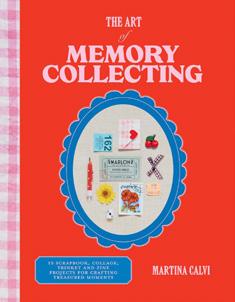
The Art of Memory Collecting by
Martina Calvi
If you’re someone who has drawers filled with photos or sentimental tokens, memory-collector Martina Calvi will show you how to preserve those precious momentos in a fabulously fun and crafty way. From scrap wall hangings to secret pocket cards, start your memory collecting today with 15 projects to choose from.

In Ocean, broadcaster and biologist Sir David Attenborough opens our eyes to a century of marine discovery, revealing the secrets of eight of the ocean’s most magnificent habitats, and the challenges they face. The book is a powerful and timely call
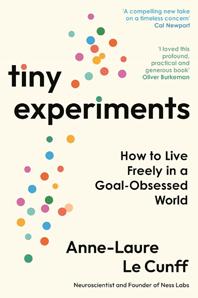
Experiments by
Anne-Laure Le Cunff
Our goals and ambitions look different to each and every one of us. That’s why, instead of telling us what we should be doing to achieve them, neuroscientist Anne-Laure has created a toolkit to help you reawaken your curiosity, and discover more about yourself through experimentation.

Ocean: Earth’s Last Wilderness by Sir David Attenborough and Colin Butfield
for change from someone who has seen it all, and dedicated his life and work to reporting on the natural world.

A Nature Poem For Every Summer Evening by
Jane McMorland Hunter
Is there really a better way to celebrate the lighter and brighter days than by losing yourself in a collection of nature poems? As poetry enthusiasts, we think not! Within the pages of this glorious book is a poem for every summer day, which captures the true beauty and nuance of the special season.
Quiet quitting is over, it’s time to try making the job you do work for you
Writing | Jemma Broadstock
We’ve all had those days when we’re stuck in a work rut, daydreaming about handing in our notice, and walking out the door in defiance. It’s more common than you might think; a recent Gallup report revealed that only 10% of UK workers are engaged in their jobs, and the What Workers Want 2024 survey reported that 40% of workers anticipate leaving their jobs in the next 12 months.
It’s easy to fall into the trap of thinking a new job is the only way things can improve – but, with rising living costs, and many people struggling to make ends meet, leaving your job or risking losing that security might not be an option. This can create a perpetually demotivating cycle, leading to the ‘quiet quitting’ phenomenon (where people mentally ‘check-out’ of their jobs, doing the bare minimum to get by). But when we’re spending a third of our lives at work, feeling engaged and enjoying a sense of accomplishment, and personal development, can make a huge difference to our wellbeing.
So, instead of mentally drafting your resignation letter, you might want to consider the process of ‘job crafting’ – an approach coined by psychologist Amy Wrzesniewski that can lead to greater satisfaction, motivation, and even improved performance. So, how do we turn the job we have into the job we want?
Reflect on the activities that make you feel energised and proud at work. Which tasks really get you ‘in the zone’? Which ones bore you? Once you know your strengths, focus on incorporating more of those into your day-to-day tasks where possible.
Job crafting is about aligning your responsibilities with what excites you, so look for opportunities to shift your workload toward what you enjoy. If you’re stuck, viacharacter.org is a useful resource to help identify your strengths.
Try this: List your top three strengths and values, then crossreference them with your current
work tasks. Can you swap out less enjoyable tasks for ones that play to your strengths? Are there ways you can adapt things you absolutely have to do so that you use your skills more effectively?
Alter your tasks and responsibilities
This doesn’t mean drastically changing your role or neglecting your responsibilities (your boss probably wouldn’t be a fan of that), but, instead, finding ways to incorporate more of what you enjoy, or what aligns more closely with your skillset. If you’re a creative person stuck doing repetitive administrative work, perhaps you can propose taking on a project that allows you to flex your creative muscles. Or if you are sitting at a desk all day but love being outdoors, maybe you can suggest starting a work football team.
Try this: Look at your weekly tasks and identify at least one you can modify to better fit your strengths. For instance, if you’re great at public speaking, volunteer to step up and lead the next team meeting.
Sometimes, the issue isn’t with the tasks themselves, but with how we perceive how purposeful they are. For instance, if your role feels repetitive or mundane, consider the broader impact of your work. How does it contribute to the company’s goals, or how does it help others? When you shift your mindset, even small tasks can start to feel more purposeful.
Research shows those who view their work as a ‘calling’ tend to experience greater job satisfaction, engagement, and wellbeing, regardless of what their work actually involves. Try this: Write down how your work directly impacts your colleagues, or a client or customer. If you really aren’t sure, ask them! Think about the bigger picture of your role, and the ripple effects that come from it. Maybe the person you served at a restaurant has been feeling isolated and lonely, but your interaction made them feel seen and appreciated.
Even if you’re happy with your job, setting goals can contribute to self-growth. Whether it’s learning a new skill, doing some continuing professional development (CPD), or improving your productivity, setting clear, actionable goals will make your work feel more exciting and focused. Plus, it’ll show your boss that you are committed to growth. This can also help to combat any feelings of monotony

with a role, by reminding you that you have the autonomy to change things and keep learning new things.
Try this: Set one small career goal for the next month. Sharing your goals with others can help keep you accountable and might even inspire them to set their own goals, too.
If you’re working in a space that feels drab, try personalising it to suit your style. Whether that’s adding plants, organising your desk more efficiently, or adjusting the lighting, a more inspiring environment can help you feel more energised and motivated. Research has consistently shown that a positive environment can boost both your mood and productivity,
with a study carried out by the American Society of Interior Designers finding that those satisfied with their office environment experienced a boost in performance and productivity. Try this: Being in blue and green spaces, such as the beach and gardens, can do great things for our wellbeing, so see if you can sit by a window, have a walking team meeting, or venture outside during break times.
Job crafting is about making small, intentional changes that align your job with your passions, strengths, and values. It’s time to stop moulding yourself to fit your job and, instead, find ways to reshape it to fit you. By making simple adjustments to your tasks, environment, and mindset, you can transform your job into something that brings you a lot more joy.
We all need to vent from time to time, so is complaining always such a bad thing? Delve into the value of letting off some steam, and discover how you can better benefit from complaining constructively
Writing | Bonnie Evie Gifford
We all love to have a little moan, whether it’s about the weather, that one colleague who never cleans up after themselves, or the ever-increasing cost of the weekly shop. While the idea of ‘complaining’ often has negative connotations, and no one wants to be perceived as being a ‘whiner’, having the chance to talk about what’s frustrating us can feel pretty good in the moment. Really, what’s more cathartic than a good venting session? So, can complaining be good for us, or should we be trying to focus on being more positive with our interactions? Let’s explore the benefits – and the potential pitfalls – of complaining.
While complaining can feel good at the time, and help to release emotions rather than bottling them up, if we let ourselves be
negative for too long, or dwell on the issues, we risk getting stuck in a negative feedback loop, making ourselves feel worse, stuck, or powerless. That’s why it’s so important to strike the right balance, helping you to complain more productively and enjoy some of the following benefits:
• A sense of release. Allowing ourselves to complain can help us to express frustration, anger, or disappointment in a healthy way. In fact, science shows that refusing to acknowledge our feelings can result in lower life satisfaction. Research, in the journal Emotion, found that the more we suppress our feelings, the more likely we are to experience greater depressed mood, fatigue, and low selfesteem, while those who are more emotionally expressive are more likely to feel more acceptance and satisfaction in their relationships with others.
• Feeling heard and connected. Venting can give us the chance to air our grievances, connect with others around us, and share our experiences. Knowing we aren’t alone in our frustrations can help us feel more confident about handling them, as well as offering reassurance that we aren’t the only ones who would be irritated in that situation.
• A low-stakes way of asking for help. Sometimes, it can be difficult to outright ask for help. You might have difficulty expressing what you are struggling with, or feel stuck over something that feels trivial. Venting can often lead to the opportunity to ask – or be offered – helpful solutions or alternative ideas that may allow you to feel unstuck, and move forward.
• New ideas and changes. We might have a complaint about a situation that, no matter how

hard we try, we can’t think of a solution. Taking the time to complain can lead to finding a sense of camaraderie from others experiencing the same issue, and may introduce you to new perspectives and ideas. They may have already overcome a similar situation or problem or, together, you may already have the start of a solution.
While complaining can provide some sense of catharsis and release, dwelling too much on the negative can lead to feeling hopeless or overwhelmed. Excessive complaining can perpetuate a negative bias, where we might start paying more
attention to negative experiences or information than positive, as it’s what we come to expect. Over time, this can lead to an overall negative or cynical view of the world around us.
Another consideration is that when we vent to friends or loved ones occasionally, they might be happy to listen and offer help, but too much can feel overwhelming for them, too. Complaining with purpose can help to avoid this (for example, getting ‘consent’ before you vent, saying if you just need to unload, or specifying if you are looking for solutions). Setting a time limit so you don’t dwell too long can also be helpful. While it’s vital to acknowledge all of our feelings, it’s also important to ensure that we don’t allow ourselves to become wholly
negative – for our own good, and for those around us.
So, how can we find the right balance that can help us to express how we are feeling, without allowing ourselves to develop a negative world view?
Consider who, when, and where you are complaining. There is a time and a place for everything – and not everyone is the right person to complain to, or may not be in the right headspace to listen. For example, complaining about your work stress to a friend who’s just lost their job wouldn’t be the most sensitive move. So, trying to put some thought into who you
are going to open up to about a particular topic is an important first step, rather than blurting out your grievances to just anyone.
Picking your time carefully is also vital. While your friend might normally be more than happy to listen to you complain, trying to bring something up at the wrong time, or derailing a conversation, can be frustrating for you both. Consider whether there is enough time (and privacy), or if it’s worth asking to catch-up on another occasion, so you can get things off your chest.
Put your gripes down in writing. Instead of dwelling in the moment, writing things down can give you the space to better think them through when you have more time, energy, or capacity to focus, and approach them with fresh eyes.
The act of taking things from your brain and putting them on a page in front of you can help them make more sense, too. Rather than abstract ideas, emotions that feel overwhelming, or thoughts popping up demanding your attention, you can determine thoughts from facts more easily when reading them in front of you, as well as trust that you can return to them at an appropriate moment.
Watch for repetition.
Do you find you still have the same complaints even after you have tried one or more solutions?
Is the same issue cropping up over and over again, or lingering in your mind? It could be a sign that what you think is bothering you isn’t the main issue, and there might be an underlying problem you need to address.
Of course, not every thing you complain about has a simple solution – or something that you have the power to change. But, even so, understanding the underlying concern, or what is repeatedly grinding your gears, can still be helpful information, and enables you to be aware of situations that might wind you up in future.
gratitude.
THE MORE WE SUPPRESS OUR FEELINGS, THE MORE LIKELY WE ARE TO EXPERIENCE
Think about the next steps. Deep dive into your concerns. What is the actual problem you’re complaining about? Why does this bother you? Is it frustrating in the moment, or something that aggravates or inconveniences you more consistently? If it’s something smaller, is there anything actionable or practical you can do to change things for the better yourself (or ask others for help)? For bigger problems, working out how to break it into smaller chunks to tackle could help you feel like you are making progress, without being overwhelmed.
While expressing ourselves and our frustrations is important, it’s also worthwhile to make time to focus on the good things in our lives. Practising gratitude can help to balance out complaints by giving ourselves time to reflect on the moments, things, and people that have brought us joy. Plus, by consciously opening our eyes to the good things in life, we can have a more objective perspective when annoyances arise, so that the things we might want to complain about don’t irritate us quite so deeply.
At the end of the day, there shouldn’t be any shame in complaining. While nobody likes to be around negativity all the time, having a bit of a moan can feel both cathartic and empowering. Sometimes it can help us find solutions, work through our problems, and move forward. And, other times, it delivers when all we really want is a moment to acknowledge that a situation, well, sucks, and that how we are feeling is valid.
At a time in life that impacts body image, eating behaviours, and coping mechanisms, a delicate yet complex link can be found between menopause and eating disorders – but why is this, and what can we do about it?
Writing | Kat Nicholls
Ahuge life transition
impacting reproduction, with fluctuating hormones affecting our minds and bodies – it’s a description that could apply to two monumental periods in life for those with menstrual cycles: puberty and menopause. Our bodies change, hormone levels dance chaotically, and emotions balance on a knife edge. Perhaps it’s not surprising that associations have been made with either the beginning of, or a resurgence in, eating disorders – stereotypically associated with teenage years – in later life, too. For some, menopause brings a sense of ease, leaning into creativity and letting go of who we ‘should be’. For others, the mental health impact is significant – and this is something that shouldn’t be overlooked.
Naturally, as we age, hormone levels begin to fluctuate. For
women, this can signify the end of their reproductive cycle, with menopause being when ovaries stop producing eggs, officially hitting this point after 12 months without a period. The time leading up to this (varying from months to years), when symptoms might display but some periods continue, is called perimenopause. Symptoms can be varied, ranging from more physical (e.g. muscle and joint pain; painful gums; dry and itchy skin; changes to body shape and weight; changes to period; hot flushes) to mental (brain fog; sleep difficulties; increased anxiety; mood swings; low self-esteem; changes in sex drive).
“Menopause involves a dramatic change in women’s sex hormones, especially oestrogen and progesterone, which have farreaching effects, not just on the body, but also on brain chemistry,” says psychotherapist Lindsay George. “Oestrogen affects
neurotransmitters like serotonin, dopamine, and norepinephrine, all of which are critical to mood, motivation, and emotional wellbeing.”
The connection between menopause and eating disorders
As with many women’s health issues, the link between menopause and eating disorders needs further research. However, a 2024 academic review, in Applied Physiology Nutrition and Metabolism, found “strong positive associations with disordered eating”, and a 2016 study in Maturitas noted changes in oestrogen levels during perimenopause could be linked to an increased risk of eating disorders.
As a 2024 study in the journal Menopause flags, approximately 3.5% experience eating disorders in ‘midlife’, and the prevalence of specific symptoms at this age >>>

can be as high as 29%. However, Umairah Malik, clinical manager at Beat (the UK’s eating disorder charity), notes: “Eating disorders have complex causes, so while it would be unlikely for menopause to be the sole cause of someone becoming unwell in this way, it can be a significant contributing factor.”
Umairah points to the hormonal and physical changes that take place. “As a result, dangerous coping mechanisms, such as disordered eating, can develop to feel ‘more in control’ over the changes occurring, or to manage difficult emotions.
“Feelings of perfectionism or low self-esteem can also impact women in their midlife, especially if they are dealing with big lifestyle changes at the same time, such as children leaving home, or caring for older relatives.”
Another contributing factor to consider is the slowing down of our metabolism, which can change body shape and weight. “These changes can be difficult to process, and can mean that women don’t feel like their usual selves, or may feel under pressure to lose weight,” Umairah highlights.
Psychotherapist Lindsay concurs, and explains that this can be especially difficult if someone has had a challenging relationship with food in the past. “If someone has a history of disordered eating or body image struggles, these changes can trigger a relapse as an individual may attempt to regain some control over their weight gain and changing body image.” It’s the combination of changing
bodies, along with fluctuating hormones, that causes a sense of instability. It seems, dizzy with change and searching for solid ground, some may lean on unhealthy coping mechanisms, such as eating disorders.
When dealing with an eating disorder during menopause, there are some particular challenges to
keep in mind. A few that Lindsay highlights include:
• Bone health risks: Both menopause and eating disorders (especially those involving restriction or purging) independently increase the risk of osteoporosis. Together, they can compromise bone density.
• Cognitive and emotional strain: Menopause is linked to mood swings, depression, anxiety, and
sleep disturbances, which can overlap with, or worsen, the psychological symptoms of an eating disorder.
• Medical complications overlap: Cardiovascular risk increases during menopause, and eating disorders can exacerbate issues like arrhythmia, electrolyte imbalances, and gastrointestinal problems, making medical monitoring more urgent and complicated.
We also can’t forget the social isolation and stigma that can appear at this time. “There can be additional stigma around having an eating disorder later in life, leading to shame or reluctance to seek help. This is compounded by the often under-discussed realities of menopause,” Lindsay says. But, it’s important to note, despite these challenges, support is available and recovery is possible at any stage of life.
The first step is to recognise when a problem might be brewing. Umairah lists some signs to watch out for: “Eating disorders can develop gradually, and it can be hard to tell if symptoms or behaviours are cause for concern. In general, if you feel that your diet or exercise routine starts to take over your life, or if you spend a great deal of time thinking about your weight, it’s worth speaking to your GP – and certainly if you start to notice behaviours such as bingeing, purging, or overexercising.”
When it comes to treating eating disorders during menopause,
professional help and self-help strategies can work in harmony.
Speaking to a healthcare professional is the first port of call. They can advise what steps to take, usually involving a combination of physical, psychological, and nutrition-based support. You can get help with hormonal changes (such as hormone replacement therapy) and any side-effects or symptoms, and may be recommended to work with a counsellor, alongside peer support groups, to help you cope emotionally and tackle the eating disorder itself. Beat has some support groups, as noted on its website, including ones open to all, as well as condition-specific (such as avoidant/restrictive food intake, anorexia, bulimia, and bingeeating).
Learning how to change your relationship with food can be key, utilising it as a tool to nourish instead of punish. A dietitian who has experience in eating disorders and menopause could be a real asset on this journey.
While you get help, any steps you can take to steady yourself are welcome. This starts by stripping away any social isolation and shame you may be feeling by reaching out to loved ones, and sharing your experience.
Lindsay says that tracking symptoms and habits can be useful on this journey – so journaling may be a helpful tool – as well as evaluating current coping mechanisms and seeking healthier
To learn more about eating disorders, visit beateatingdisorders.org.uk
ones, “like hobbies, socialising, or relaxation techniques”. Our sense of identity can get lost during menopause, so any activities that bring you back to ‘you’ can make a big difference.
“Practising self-compassion and body acceptance helps, too,” Lindsay says. “Engage in activities that promote positive self-esteem, like mindfulness, yoga, or bodyneutral affirmations, rather than harsh self-criticism.”
Understanding the magnitude of menopause is something, societally, we need to work on. Raising our awareness of this, and recognising our vulnerabilities, can help us speak up when we need help.
“While eating disorders are serious, they are treatable, and it’s completely possible to go on to live a full and happy life, with a healthy relationship with food again,” Umairah reminds us. “It is essential that you get help at the earliest opportunity, however, as it gives you the best possible chance of making a full recovery. You are not alone.”

Lindsay George is a counsellor, psychotherapist, and trained nurse. Connect via the Counselling Directory.
We’re putting community initiatives in the spotlight, and, in this issue, we’re highlighting the national swimming group making a splash…
Writing | Caroline Butterwick
On the pebbled shore of a loch, several people step forwards into the cold lapping water, laughing and smiling. Some swim, while others paddle or wade. Afterwards, as they warm up, homemade cake is shared while people chat, or simply take a moment to themselves.
Mental Health Swims is a charity dedicated to bringing people together to swim, creating inclusive spaces that empower you to enjoy the water, while fostering a sense of community.
“I received a mental illness diagnosis in 2018, and it came with a warning of the stigma I might experience,” says Rachel Ashe, the founder of Mental Health Swims. “As I was coming to terms with what it meant for me, what it meant for my past, what it meant for my future, I wanted to meet other people who understood what it’s like to live with mental illness.”
In 2019, Rachel leapt into the freezing waters of the Firth of Forth, as part of the famous New Year’s Day dip in Edinburgh. “I wouldn’t recommend anyone start on New Year’s Day – it’s not the time to start safely,” she notes. “It was horrible, so cold. But afterwards, this really bizarre thing happened, where, as I was
walking up the beach, and the burn of the cold was wearing off, I felt a glimmer of hope. There was something, and I was like, ‘Ah, this is different.’ I just felt more myself, I suppose, or the version of myself that I wanted to be. Hopeful.”
Inspired, Rachel continued openwater swimming, but wanted to create a space that was specifically for mental health. She set up a group locally and, spurred on by its success, developed Mental Health Swims into a national organisation. It now has more than 100 groups spanning England, Scotland, and Wales, has supported 30,000+ people, and trained more than 400 volunteers.
One of those volunteers is Audrey, who was diagnosed with anxiety and depression, and experiences agoraphobia, so finds it difficult to leave the house. She had tried other swim groups, but didn’t feel as welcome as she’d hoped. Then, she discovered Mental Health Swims and became a regular participant, going on to train to become a co-host at her local group at White Loch, near Newton Mearns, Scotland.
“You have to overcome so much in the water, it makes you more resilient,” says Audrey. “It develops your trust in people. Through all my years of being involved in
mental health, I’ve never been part of something that is so powerful, transformational.”
The resilience Audrey feels is a common experience; one 2019 research paper, published in the journal Qualitative Research in Sport, Exercise, and Health, examined the wellbeing benefits of sea swimming. The study found that swimmers experienced an increased sense of psychological resilience, improved self-belief, and were able to find “alternative and expanded perspectives about themselves and their world”.
Being part of Mental Health Swims has supported Audrey’s mental health hugely, including helping her leave the house. “I think I had lost myself in all my illness, but I feel the water and the group have helped me find the real me again,” she says.
Pauline, a member of Audrey’s group, reports similar benefits. She first attended in August 2024, and is now a regular at the monthly swim that sees up to 20 people swimming together. “After a session, I feel amazing,” Pauline says. “In the water, it’s like all the weight has been lifted off your shoulders – although sometimes it brings tears of relief of the pain you are suffering. It sets you up for your day or week.

“It makes me feel I’m capable of anything, and others can coax me to try new things,” Pauline adds. “I’ve made so many friends, and we’ll be friends for ever, I believe. We have a group chat, and look out for each other if we’re having a difficult time.”
Rachel highlights how they train all of their volunteer hosts on mental health, risk assessments, and cold water safety, and that many have lived experience of mental health issues themselves. They also make it clear that the swims are about supporting people with mental health conditions, using a peer support model (where people with similar experiences come together) rather than being general wellbeing groups.
Initiatives like this are really an ideal wellbeing combination, as there’s growing research into the benefits of open water swimming. A preparatory study by the University of Portsmouth
into the effectiveness of outdoor swimming to help people reduce symptoms of depression showed ‘promising’ results, with reductions in symptoms of depression and anxiety. The aforementioned 2019 research paper found that participants seemed to “derive a deep sense of connectedness and belonging from swimming”. This included feeling connected to the other swimmers, and a sense of belonging to a community.
Open water swimming has increased in popularity, especially since the pandemic. It’s a free way of being active, and swimming without a gym membership, and members of the Outdoor Swimming Society (OSS) cited the importance of being in nature as a motivating factor. Overwhelmingly, an OSS survey revealed that 94% of people chose to swim outdoors due to the “joy”, expressing that they felt happier and less stressed in the aftermath.
And, for Rachel, the emphasis of Mental Health Swims is very much on these mental and emotional effects, rather than aiming for swimming PBs. “It’s more around the welcoming spaces,” she says. “We take a very ‘dips, not distance’ approach, because if you say, ‘cold water’, that can also bring to mind triathlons and sitting in ice baths, and that isn’t us. This is more about enjoying being in or near water, and spending time with people.”
Mental Health Swims also holds indoor swimming sessions through its Swim Together programme, opening their work to those who can’t access outdoor swimming, or don’t feel confident in doing so.
The swim map on Mental Health Swims’ website shows where groups take place, and you can contact them if you have any questions. As a charity, it works on a donation basis, and you’ll need your own kit, such as weatherappropriate swimwear (e.g. wearing a wetsuit if it’s cold), and warm clothes to change into.
“I believe anyone suffering with a mental illness should try these swims,” says Pauline. “You don’t have to swim – you can dip, or just enjoy the company. Just give it a try. I did, and it’s changed my outlook on life for good.”

I
Integrative counsellor and therapist Fiyaz Mughal OBE explores how you can let go of self-criticism with OCD
Read more about Fiyaz on the Counselling Directory.
How can OCD impact a person’s life?
AObsessive compulsive disorder (OCD) can have a significant impact on a person’s life. It’s part of the anxiety spectrum of disorders, and thereby linked. The two elements that have the greatest impact are intrusive thoughts, which are most worrying and destabilising,
QCan OCD cause feelings of shame and selfcriticism, and why does this happen?
AWhile OCD is a difficult condition to manage, many people do, and they live happy and fulfilled lives. However, shame can keep people in a complex cycle of trying to cope with ruminations.
and the compulsions that eat into the time, and take people away from the things that they enjoy and value in life.
Intrusive thoughts may make people feel that they are different, weird, or terrible in some way. They are called ‘ego-dystonic thoughts’. This makes some people withdraw, strengthening the ruminations and reinforcing compulsive
behaviours. People may think that they are inherently bad, disconnect from loved ones, and go into compulsive behaviours that further limit their lives. The impacts of OCD are significant – economically, mentally, and emotionally. It can be a debilitating condition for those who do not have adequate and helpful coping and management techniques.
Intrusive thoughts can be so shame-inducing (as well as frightening and emotionally shocking) that they create a barrier for the person to voice them in therapy, or to seek help. The shame of thoughts can restrict people, and this may also extend to the compulsions.
Shame is another layer to the defensive reactions that
become multi-layered over time for people living with OCD. The sense of self-isolation and pain can become deeper, and the ability to seek professional help seems even farther away. I would say that there is a core quad of processes that keep the cycles of OCD strong, until they are worked through in therapy: ruminations, shame, compulsions, and hopelessness.

QHow can counselling help someone with OCD let go of shame?
ACounselling can help shine a light on the intrusive thoughts, allowing people to voice them and know that they, as people, are accepted, and that thoughts are just that – thoughts. Voicing the intrusive thoughts takes the power away from them, helping clients to feel that they are not ‘abnormal’ or ‘bad’.
Voicing intrusive thoughts is important to cut through the shame which seeks to keep them internalised. Once the
shame starts to fall away, people begin to engage more in the counselling process, and feel able to connect with others, seek help, and also seek to regulate themselves through personal connections.
Vocalisation is important to reduce shame, and this gives people another way of looking at their intrusive thoughts that does not make them connect wholly to their sense of self and personal identity. This can be the start of reducing the internal pulls of intrusive thoughts that draw individuals to get stuck in ruminatory cycles, and repeating compulsive behaviours.
What are your top tips for fostering selfcompassion with OCD?
• Try to realise that thoughts are just that: thoughts. Everyone has intrusive thoughts, but it is the degree of believing in them, and engaging with them, that separates those with OCD from those who don’t suffer from the condition.
• Intrusive thoughts do not define you. Intrusive thoughts are fundamentally opposite to the core social and moral values of individuals with OCD.
• Anxiety and OCD are not ‘enemies’ or out to ‘get you’. They are coping mechanisms that your body and your mind use for difficult stressors and life experiences. Historically, these coping mechanisms may have helped you once, but they are not helping now, and reframing this truth can change your relationship with OCD.
• Remember that many people live fulfilled and fruitful lives with OCD. OCD does not hold them back and, in many ways, has shown them the true person that they are – helpful, emotionally caring, empathic, and motivated to help others.
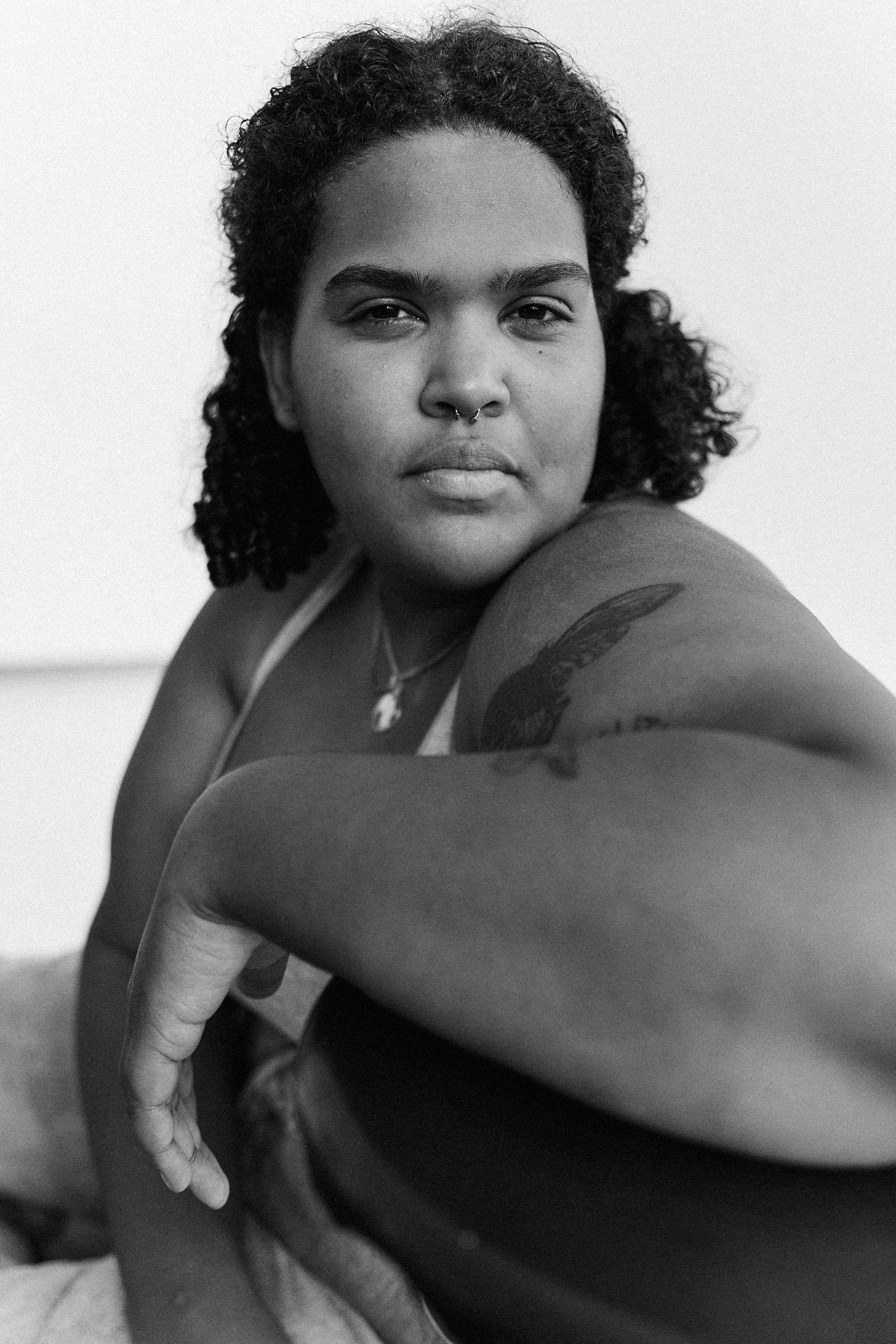
The most common way people give up their power is by thinking they don’t have any
Alice Walker
Do childhood bonds shape relationship success? Here, we explore the four attachment styles, and how we can use them as a framework for self-reflection and creating space for supportive connections
Ithink you might be going out with another avoidant,” were the words I recently said to a close friend who’s on the dating scene, possibly making a snap judgement about some early signs of emotionally unavailable behaviour (or my interpretation of it, at least).
As a mental health writer, I’ve encountered attachment theory before, and felt connected to the concept that early bonds with our caregivers can shape our adult relationships. But, perhaps, I’ve unconsciously slipped into the trap of pigeonholing behaviour, especially after seeing the many rapid-fire ‘attachment style’ posts that pop up on my online algorithm.
So, I was excited to dive deeper into the four different attachments – secure, avoidant, preoccupied (or anxious), and disorganised – and, more importantly, open up a conversation about how we can better support and love each other, moving forward.
Known as the father of attachment theory, British psychologist John Bowlby extensively researched attachment styles, highlighting how the parent/child relationship establishes our expectations and needs in adult relationships. Bowlby believed that strong emotional connections with caregivers were a part of human nature, with the attachment figure providing what is known as a “secure base” in which the child can explore their environment, and a “haven of safety” during moments of distress or threat. His research indicates that being close to a protective adult is crucial to evolution, and keeping babies safe from potential danger.
Psychologist Mary Ainsworth translated Bowlby’s work into practice with her Strange Situation assessment, discussed in 1970 in the journal Child Development.
During the study, researchers observed how each child behaved when their mother left the room, and how they responded when she returned. Based on these observations, Ainsworth concluded that securely attached children seek comfort from their parent, anxiously attached children show much upset when the parent leaves but aren’t comforted when they come back, and avoidantly attached children look for little comfort from their parent.
Later, in 1986, researchers Main and Solomon proposed a disorganised attachment style, in which children displayed conflicted or even fearful behaviours as they reconnected with their caregiver after separation.
The theory takes the idea that these childhood bonds can lay the groundwork for future relationships, and influence attachment patterns in later life.

As you read about attachment, how do you feel when you get close to someone? Perhaps you feel at ease, or maybe you get overwhelmed, scared, or anxious. Many would say the latter, and that’s OK. Let’s work through the four attachment styles, and how to feel more secure in your relationships.
Someone with a secure attachment tends to have good self-esteem and a healthy communication style, understanding that they deserve love and respect. A secure attachment generally means feeling comfortable in close relationships, and when spending time alone.
Attachment theory reveals that individuals who feel they can count on others in adulthood had their emotional needs met when growing up. A study published in the American Psychological Association journal shows that 51.6% feel securely attached to their primary caregivers, while just under half feel otherwise. Having been in a relationship with my husband for nearly 25 years, I wanted to ‘tick off’ securely attached – but then I really explored the avoidant attachment style.
An avoidant or dismissive attachment style can manifest
as keeping people at a distance and feeling trapped in relationships. It can result in hyper-independence, or a need to maintain control to avoid feelings of vulnerability or emotional intimacy.
Feeling like you don’t belong can be at the root of this self-sabotage pattern, and, according to attachment theory, you may have experienced neglect or rejection from one or more of your parents growing up. This trauma can be overt, or manifest as a parent falling short of your needs, such as playing down your emotions. If you recognise these patterns, try to remember that you don’t need to do it all by yourself. Communicating your wish for appreciation and positive reinforcement, especially when it comes to practical support, can help you connect more fully.
A preoccupied or anxious attachment can bring to light a fear of rejection or abandonment, resulting in insecurities, jealousy, or ‘clingy’ habits.
The need to hold on tightly in romantic relationships can be a reaction to inconsistent or unpredictable parenting, such as a parent who swings between being detached and pulling you close, or making you feel responsible for their emotions. If this rings a bell, self-soothing, such as positive affirmations or grounding techniques, is key to anxious attachment healing.
Developing good boundaries can also help you prioritise your wellbeing. Moving away from external approval with the aim of seeing yourself as an equal can, over time, mean you’re able to meet your own needs.
A disorganised or fearful attachment can show signs of both avoidant and preoccupied styles, such as fluctuating between anxious, angry, or possessive to withdrawn, or extremely self-reliant. This confusing behaviour can be due to the chaotic environment experienced at home, which, for some, can include persistent neglect or trauma, and, for others, can feel like they never know what they’re going to experience from one day to the next – otherwise known as eggshell parenting. Instability in childhood can mean being hypervigilant or untrusting of your partner in adult life.
Feeling unworthy can be at the core of this behaviour, and, if this strikes a chord, working through healthy relationship skills and developing a sense of self-compassion can help build loving connections, and lessen the overriding instinct to protect yourself from getting hurt.
What’s true is that we all need to love and feel loved, and attachment theory teaches us
It’s important not to oversimplify ourselves, so we can view this theory as a doorway to deeper work
how to do this better. However, it’s important not to oversimplify ourselves, so perhaps, instead, we can view this theory as a doorway to deeper work. Knowing our main attachment style and understanding who we’re attracted to is just the first step to developing the self-awareness needed to challenge negative thought processes, and be emotionally available. But it’s the beauty of consistency that urges us to take responsibility for how we treat ourselves and others on an ongoing basis.
Some of us may slot neatly into one of the four attachment styles, however, our connections can differ depending on our circumstances and stage in life, so I’m open to this being a spectrum – and not forgetting the element of surprise.
We’re a tender mix of many traits, after all – but it’s these layers and complexities that give us the strength to evolve and understand each other better.

Welcome to Anxiety on Your Mind, the series where we explore the reality of living with anxiety. In this edition, Sian Dennis, 33, from west Berkshire, shares how she navigates mental illness while living alone
Writing | Sian Dennis as told to Fiona Fletcher Reid
Anxiety has been a part of my life for more than a decade. Even on good days, it’s lurking in the background. I also live with depression, which means my brain is constantly at war with itself. One part shouts, “You’re not doing enough!” and the other whispers, “What’s the point?” It’s kind of exhausting. Even though my anxiety wasn’t particularly bad at the start of the week, I took full advantage of the bank holiday Monday and made a commitment to rest. I limited my social media scrolling, finished a book I’d been enjoying, cooked a healthy dinner, and snuggled under a blanket on the sofa.
I work remotely as a content strategist and copywriter for a global software company. The team is mostly based in North America and I live alone, so I can feel quite isolated at times, which leads to overthinking. To combat this, I make sure to take a walk after dinner and before the day wraps up, I also call my mum for a quick chat, just to break up the day and feel that sense of human
connection. Connecting with another person, even if it’s just for 10 minutes over a video call, can make all the difference.
Later in the week, I do something I’ve been dreading – I update my monthly budgeting spreadsheet. Recently, a lot of my regular outgoings have increased, which heightened my financial anxiety. Living with financial anxiety during a cost-of-living crisis is tiring, especially as a single person who has to manage everything alone. There’s no one to split the bills with, or share the weight of rising costs. During times like these, it dawns on me that it really is just me, figuring all this out alone. No matter how carefully I budget, the pressure to stay on top of everything, while still trying to enjoy life, is relentless.
Thankfully, I’ve got quite good at using preventative strategies to minimise my anxiety. On Thursday I go to an early morning pilates class to ease some of the tension in my body. Medication has also been an important part of my toolkit, and
I recently doubled my dosage. Unfortunately, it has come with some side-effects, but I know it’s worth it in the long run. I wish there were less stigma and fear around taking medication. Yes, perception has improved, but at times, people still act as if taking medication for anxiety is a last resort, or that it means you’ve failed at managing things on your own. But that’s simply not true. Medication can be an essential part of managing anxiety, just like therapy or lifestyle changes. In the evening, I cook a meal from scratch. The cooking process – chopping, stirring, seasoning – gives me something tangible to focus on, which helps distract my anxious mind and pulls me back into the present. It’s also a small, but satisfying, reminder that I’m capable of taking care of myself. On days when I feel like I haven’t achieved much, cooking a simple meal gives me a sense of accomplishment. The creative side also feels good, whether choosing ingredients, trying out a new recipe, or making something from nothing.
At the weekend, I go for brunch with a friend who also lives with anxiety. It helps to talk to someone who understands. The rest of the weekend is spent napping, reading, and walking in nature. On Sunday evening, I like to sit down with my planner and map out the week ahead – it’s a routine I’ve grown to appreciate, because it helps make the following days a bit more manageable. A busy schedule is anxiety-inducing for me, so I write a list of no more than three tasks per day –anything more is unrealistic. I’ve
learnt the hard way that there’s nothing more demoralising than starting the week with a long, impossible to-do list that I’m never going to finish. It’s about being honest about what I can actually manage, and not setting myself up for failure before the week has even started.
I also pick one primary goal to focus on for the week. It could be as simple as ensuring I go to an exercise class, or cleaning the bathroom. I then write out a few positive affirmations. Seeing everything written down takes it
out of my head, and gives me a visual plan I can work with. It’s this sense of structure that helps to calm my anxiety. When I was first diagnosed, I didn’t really know how to manage my anxiety. I thought I had to push through, or worse, that I should be able to ‘fix’ it with sheer willpower or a yoga class. Over time, I’ve learnt to stop fighting my anxiety, and focus on knowing my triggers and utilising the tools that work for me. I don’t struggle in silence anymore, and I don’t treat it like a big, ugly secret.
When romantic relationships end, we often cling on to the habitual connection. But cutting ties completely can sometimes be a healthier way to heal. Here’s how to make it happen…
Writing | Elizabeth Bennett
Going no contact with an ex-partner is often an essential part of the process of ending a relationship. It gives both parties space to grieve the relationship, and move forward in a positive way. However, ‘no contact’ is often easier said than done, especially in the initial stage when the breakup feels very fresh.
“Breaking ties with an expartner is more than an emotional decision, it’s a neurobiological process,” says psychotherapist and trauma specialist Tina Chummun. “Research suggests that ending a romantic attachment can, in some cases, be compared to giving up addictive substances, which explains why the early stages of going no contact can feel so unbearable.”
However, when you understand the science behind attachment, withdrawal, and healing, you can take proactive steps to rewire your brain for resilience, keep up the no contact, and feel happier as a result.
It can be helpful to understand what’s going on with the chemicals in our brains when we cut off contact. This helps us understand why this process can be so difficult, and to develop self-compassion for ourselves. “In relationships, the brain releases dopamine, oxytocin, and serotonin – neurotransmitters that create emotional bonds and a sense of security. When a relationship ends, dopamine levels plummet, leading to withdrawal symptoms akin to substance dependence,” Tina explains. It sucks, but it will pass.
One of the main reasons why no contact often feels so distressing is because it activates the part of the brain that is to do with primal survival mechanisms. “The amygdala, the brain’s emotional alarm system, reacts to rejection as if it were a physical threat, which then triggers a stress response,” says Tina.
Naming emotions in a clear way can be really helpful here. “For example, when we say something to ourselves like ‘This is the pain of rejection; this is not danger,’ it will activate the prefrontal cortex, calming the amygdala,” Tina suggests.
We can say these phrases in our head, out loud, or write them down so that the message is really clear. Repetition is key, so saying or writing them multiple times can be very effective, as well as doing the repetitions every day.
In order to successfully break the pattern, Tina emphasises it’s important to minimise triggers that reinforce the dopamine loop. “Removing social media connections, deleting messages, and establishing structured daily routines help break the reinforcement cycle,” she confirms. The longer you can go without making contact, the better, and the longer you go, the easier it will get.

The trauma of the end of a relationship can lead to anxiety as the body enters fight-or-flight mode. When we are in this heightened state, we are more likely to reach out to our ex. As an alternative, try techniques to calm the body and mind. “Engaging the parasympathetic nervous system through yoga, slow breathing (breathe in for three, hold for four, and breathe out for five seconds), and cold exposure, lowers cortisol and stabilises emotions,” Tina recommends.
When trying to go no contact, many people struggle to keep it up, despite knowing that logically it is the best path for them. It can be easy to go round in circles convincing yourself that it’s a sensible decision to make contact, even though you previously decided it was the right thing for you not to. Tina says this is because the prefrontal cortex governs logical thinking and impulse control, and this is weakened by emotional distress. One helpful technique for combating this is to use
journaling when you’re tempted to reach out. “Writing down the consequences before acting can help you resist urges to send that message, or make that call,” Tina advises.
After a difficult breakup, when going no contact is tough to stick to, it’s important to remember that these feelings won’t last forever. “Neuroplasticity – the brain’s ability to rewire itself –ensures that emotional wounds are not permanent. Over time, old neural connections fade while new, healthier pathways form,” Tina points out. One of the most effective ways to encourage this process is by opting to engage in activities that reinforce new neural pathways, such as learning a skill, travelling somewhere new, or deepening your social connections. As an added benefit, doing these new things help to build confidence, which will reinforce your ability to keep up the no contact rule. Plus, by concentrating on yourself, the less power your ex will have over your time and energy, meaning the craving to reach out will naturally fade.

Tina Chummun is an accredited psychotherapist and trauma specialist. Connect with her on the Counselling Directory.
Name-calling Insults and belittling Manipulation Gaslighting
Financial control Withholding affection Intentional humiliation Threats
Damaging your belongings or property
Physical harm Using time to pressure you into decisions Unfounded accusations and mistrust
Isolating you Making you feel inferior Dismissing your feelings Ignoring boundaries
Ready for a brew? While you wait for the kettle to boil, why not learn how to recreate the magic of Chinese tea ceremonies…
Writing | Fiona Fletcher Reid Illustrating | Rosan Magar
Whether you prefer calming camomile or a freshlymade builder’s brew, chances are you’ve slurped one of the five billion cups of tea that are consumed globally each day. For us Brits, tea is baked into our everyday culture – serving as a popular alternative to morning java, a much-needed break from the daily grind, or an offering of sympathy to a grieving friend, to name just a few. Our tea-making habits are so predictable that the National Grid is obliged to forecast electricity needs for large events – like World Cups and major TV moments – to avoid service disruption, such as in 2011, when 640,000 kettles boiled across the country as audiences tuned in for the Royal wedding. But, there is a contemplative approach to tea that you may not be aware of, where every sip is an invitation to slow down and be
present. Chinese tea ceremonies – or ‘gong fu cha’ – may not be commonplace in British homes, but they hold untapped wellbeing benefits that are worth exploring.
What is gong fu cha?
There are several different kinds of Chinese tea ceremony, but the most common is the gong fu cha, which translates to ‘making tea with skill’ or ‘tea with effort’. It refers to a Chinese method of tea preparation that emphasises careful brewing techniques and attention to detail. Often misrepresented as a traditional method with ancient origins, records suggest that gong fu cha originates from an 18th century brewing style local to the Chaozhou region of China, which was later popularised in the 1970s, making it into the contemporary Chinese practice we see today.
“The traditional Chinese tea ceremony is a style of brewing
that can vary immensely in equipment and resources used, but, essentially, is about hosting guests and serving them an experience, or creating a beautiful experience for yourself,” explains Annelise Bennett, tea specialist and boutique manager at Newby Teas. “Less formal than a Japanese tea ceremony, gong fu cha is less structured and ritualistic. But, this ceremony is more than just brewing tea, it is a lifestyle encompassing tea that encourages the brewer and their guests to slow down and relish tea, its flavour and context, as well as good company and conversation.”
Hosts will prepare a selection of looseleaf teas, encouraging their guests to connect mindfully with every detail of the ceremony, from boiling the water and rinsing the tea, to warming the cups and serving the perfect pour. Special utensils such as >>>

Gaiwan is a thin-walled drinking vessel used for making and drinking tea, consisting of a lid, bowl, and saucer. According to Chinese folklore, these three parts are designed to symbolise harmony between heaven, man, and earth.
scoops, tongs, clay teapots, and small cups allow the host to skillfully brew tea to the perfect flavour, which is central to the whole experience.
“Gong fu cha is brewed with more tea-to-amount-of-water than more western styles of brewing, and for much less time,” explains Annelise.
“This means the leaves retain their taste for multiple steeps, anything from five to 20 steeps. Part of gong fu cha is appreciating how the flavour of the tea changes with each steep.”
More than a quick morning cuppa to get you out the door, gong fu cha is an invitation to slow down and envelop ourselves in the intricate process of making tea, be mindful, and drink with a meditative attitude.
Health benefits of Chinese tea ceremonies
Although the active compounds in tea have been linked to positive effects on depression, anxiety, and sleep disorders, the effects of tea ceremonies on mental health is currently unknown. However, one randomised control trial published in Explore: The Journal of Science & Healing looked at the wellbeing benefits of drinking tea that had been ‘treated’ with good intentions by three Buddhist monks. The results showed that those who believed they were drinking treated tea had a strong positive improvement in mood, suggesting that tea-making as a spiritual practice has potentially therapeutic effects.
Black tea contains flavonoids, which, when consumed on a
regular basis may help manage or reduce the likelihood of conditions such as cardiovascular disease, high cholesterol, and high blood pressure. A 2023 poll of 1,000 UK adults, conducted by Perspectus Global, found that middle-aged and older adults think tea is great for hydration and boosting mood, while younger adults drink tea to help ease and relieve stress.
One thing that doesn’t need scientific backing is the idea of tea as a ritual, and this is where the magic happens. “The idea of slowing down and appreciating how far history has come for us to drink tea, as well as how much has had to happen for us to have the tea in front of us today, and appreciating the fortune we have to taste and enjoy the tea, is something that can benefit many people,” says Annelise. “It can help us focus, connect, and practise gratitude.”
Anyone for a cuppa?
Here are some tips on how to add some ceremony to your own teamaking rituals:
• Opt for the best tea you can afford. According to Annelise, high quality tea can be brewed multiple times to release changing flavour, whereas a lesser quality tea will not. “I would recommend Golden Needle for a smooth chocolatey and nutty flavour profile, as well as the Yunnan Silver Needle which has deep herbaceous notes. Typically, Oolongs and Pu Erhs are best for 10+ steeps, and something
Infused with wellbeing benefits
• Lavender: soothing, helps sleep
• Lemon: supports digestion and improved mental clarity
• Camomile: reduces stress and aids sleep
• Peppermint: mood-boosting, aids memory, reduces anxiety
• Green: improves focus and mood
like Newby’s Wild Flower Oolong changes from delicate floral notes into deeper vegetal flavours as it is brewed.”
• Elevate your experience with a gaiwan or traditional clay teapot. The porous clay absorbs and improves the flavour of certain blends of tea.
• Always start by warming up your teapot with boiling water. This will reduce the temperature shift inside the teapot, which can affect the flavour of the tea.
• Consider rinsing your tea leaves, depending on the blend you’re using. Fermented teas, such as Pu Erh teas, may contain traces of dust, mould, or bacteria. Pour some hot water over your leaves to rinse them, then drain away the water.
• Refill the teapot with boiled water, cover and leave for a few seconds to preserve the aroma of the tea. Continue to pour hot water over the tea and allow it to brew for the time specified by the manufacturer.
Warm your cups (small ones are traditional) and pour your tea when it is ready. Take a sip and savour the fruits of your labour!

As a special thank you from the Happiful team to you, monthly print subscribers will now receive thoughtfully crafted gifts at milestones in their journey – in addition to their monthly delivery of positivity!*
Six reasons to subscribe today:
• Rewards include guided journaling booklets, seeded affirmation cards, and beautifully designed notebooks – completely free!
• Award-winning psychotherapist-reviewed and approved content
• Packed with fascinating features, science-backed practical tips, inspiring stories, and expert advice
• Print-exclusive guided journaling pages in each edition
• Includes free postage & packaging to UK addresses (excluding NI)
• You’re in control, so cancel any time
And remember, the longer you keep your subscription rolling, the more rewards you’ll receive! So committing to your wellbeing is truly rewarding, in more ways than one.
Join today at shop.happiful.com
Whether you’re curious about Alcoholics Anonymous, or want to understand your options on a sobriety journey, the value of group connections shouldn’t be underestimated
Writing | Luke Clark
Acommunity hall, chairs arranged in a circle, lukewarm coffee and biscuits at the side – when you think of support groups, this is probably the image that springs to mind. Presented in countless TV shows and films, Alcoholics Anonymous (AA) is undoubtedly the most well-known, but what is it actually like to attend a support group? Do they really help? And, is it right for you?
Perhaps you’re sober, or sober curious. Maybe you’ve been thinking about cutting back on drinking for a while, or you’ve had that one moment where you realised alcohol was doing way more harm than good. That was me, three years ago, waking up
in the doorway of a bookmakers after another blackout. I’d struggled with anxiety and depression for several years and alcohol wasn’t helping – it was pouring petrol on the fire. That moment was my rock bottom. And I knew something had to change.
Since then, I’ve been on a mission to build a life I don’t want to escape from – one that’s hangover-free, anxiety-light, and full of community. Through my podcast, ‘The Stress Sessions’, and connecting with others in person and online, I’ve realised just how powerful shared experiences are. That’s exactly what support groups like AA are built on.
What even is AA?
AA is a peer-led community of people who want to stop drinking, and support each other while doing so. It’s been around since the 1930s, and follows a 12-step programme to help people stay sober, one day at a time. There are 4,600+ weekly meetings across the UK, with more than four million annual attendances. That’s a lot of people walking through the same doors, looking for the same kind of support – and finding it.
It’s free, open to anyone who might have a problem with alcohol, and completely anonymous. You don’t need a referral, you don’t have to sign up for anything, and you don’t even have to say a word if you don’t want to.
>>>
“But isn’t AA really formal… and a bit culty?”
Honestly, before I started researching AA, that’s what I thought too. I imagined a big, cold hall with fluorescent lighting and awkward silences. In reality, it’s nothing like that. People show up, share their stories (if they want to), and support each other. Some meetings are even in coffee shops, community centres, or online. There’s no pressure. And absolutely no judgement.
You’ve probably also heard that AA is pretty religious. And yes, it does talk about a “higher power”, but it doesn’t have to be about God unless you want it to be. For some, that higher power is faith. For others, it’s the group itself, nature, inner strength – or even a cat named Phil. The point is: it’s yours to define based on what supports your sobriety goals.
What actually happens at a meeting?
There’s usually a bit of structure: a welcome, some readings, people sharing their experiences, and a closing message. You only use first names – no one’s swapping TikTok handles – so, everything’s completely anonymous. And, if you want to sit quietly and just listen? That’s 100% fine. Loads of people do.
There are open meetings (anyone can go), closed meetings (for those trying to achieve or maintain sobriety), and online options – a game changer for accessibility. The whole thing is built on connection. No one’s there to fix you, but they get you. And sometimes, that means everything.
Community doesn’t have to be big, loud, or public. It just has to be there
power of ‘me too’
AA works because it’s not a lecture or a list of dos and don’ts –it’s people with lived experience, sharing what’s worked for them. And the science backs that up. A 2020 Cochrane Review found that AA and similar 12-step programmes may be more effective when it comes to staying sober long-term – with 42% of participants in AA remaining sober a year later, compared to 35% of those using other treatment methods.
Add to that a 2022 survey from AA UK, where 83% said helping other people, and 81% said the sense of belonging, helped them maintain sobriety, and you can see why people keep going back to meetings. When you feel seen and understood, change becomes a whole lot easier.
calling
While AA is perhaps the most well-known support group, it’s not the only option – and the benefits of connecting with others, and having that network beside you, ring true regardless of where you turn to. I can attest to finding huge support through other sober spaces, especially online, so if it doesn’t sound like the right fit for you, there are other places ready to welcome and support you.
Sober Girl Society (SGS) was one of the first communities I came across. Founded by Millie Gooch in 2018, SGS is now the world’s largest sober and sober-curious community for women. What started as an Instagram page is now a global movement – full of meet-ups, events, and non-judgy, relatable content. Millie’s posts, drink recommendations, and honest chats, were a lifeline for me in those early days. When SGS started hosting mixed-gender events, I finally got to go along. I was nervous, obviously. But within 10 minutes, I was deep in conversation with someone else who had quit drinking for their mental health, and used to use alcohol as a crutch in social situations. That chat was a turning point for me, because it reminded me how good a sober connection can feel. Someone else who has inspired me online has been mental health advocate Dr Alex George. He’s now been sober
for more than two years, and listening to him speak openly about alcohol and anxiety helped me feel less alone. He even launched a men’s mental health app (Mettle) and was appointed the UK Youth Mental Health Ambassador. As role models go, he’s a brilliant one for the sober community.
Finding your people is half the battle
Peer support is the secret sauce of sobriety. It doesn’t matter if it’s through AA, Instagram DMs, or WhatsApp chats at 11pm when you’re tempted to go to the pub. What matters is feeling like you’re not doing this alone. One of my most solid sober friendships started when I replied to someone’s Instagram post about being six months alcohol-free. We now check-in every week. No pressure, no performance – just honest chat.
And that’s the magic of it. Community doesn’t have to be big, loud, or public. It just has to be there.
If you’re thinking about AA (or sobriety in general)…
Here’s what I’ll say: you don’t need to have lost everything to consider AA, or any other support group. You don’t need to label yourself an alcoholic. If alcohol is controlling your life, your mental health, your energy, or your relationships, you’re allowed to seek support.
Maybe your first step isn’t going to a meeting. Maybe it’s listening to a podcast (mine’s called ‘The Stress Sessions’, if you fancy it), reading someone’s story, or just admitting to yourself that something needs to shift. That’s still a step.
And if you do decide to check out AA, all I ask is that you go
there with an open mind. You might just find your community. Alcoholics Anonymous offers free, peer-led support for people who want to stop drinking – with no strings attached. It works for millions because of one simple truth: connection is powerful. Whether it’s AA, Sober Girl Society, or a friend on Instagram who just gets it, community can carry you through the hardest of days.
Sobriety isn’t about restriction – it’s about choice. It’s about waking up fresh, being proud of your decisions, and building a life that works for you.
So, if you’re on the fence, here’s your sign. Try it. Reach out. You’ve got nothing to lose… and a whole lot to gain.
Luke Clark is an award-winning mental health podcaster and host of ‘The Stress Sessions.’ Follow him on Instagram @stresssessions
With so many genuine reasons to feel hopeless about climate change, there is evidence that nature has the power to bounce back…
Writing | Fiona Fletcher Reid
Despite the sense of impending doom that colours almost every climate change headline, conservation projects across the globe continue to inspire hope. While there may not be one single action that can reverse the damage done to planet Earth, laser-focused conservation measures are showing that success is possible. From protecting endangered species to lowering harmful emissions, we’re rounding up some of the more positive changes of recent years, that should be celebrated, and offer inspiration.
Located a few degrees south of the equator, Rwanda is one of only three countries in the world where you can see mountain gorillas in their natural habitat. In the past, hunting had a significant impact on their numbers, with fewer than 300 known mountain gorillas in the 1980s. But thanks to collaboration between the public and private sector (which included anti-poaching patrols and the removal of snares),
there is now a thriving gorilla population. The last gorilla poaching incident in Rwanda occurred in 2002 and there are now more than 1,000 mountain gorillas in the wild.

Restoration Forth, in Scotland, is leading the way in planting seagrass – the flowering plant that helps fight climate change, improves water quality, and reduces coastal erosion. Amazingly, a meadow twice the size of a football pitch can support 80,000 fish and a million invertebrates, yet we have lost up to 92% of our seagrass meadows in the UK. However, local volunteers have helped to plant 220,392 seagrass seeds around
Firth of Forth beaches. Plus, the team has reintroduced 10,000 European flat oysters into the area after a 100-year absence.
World surpasses 40% clean electricity
Emissions from fossil fuels are one of the main causes of global warming, but, in 2024, more than 40% of the world’s electricity was generated from low-carbon
sources, according to analysis from clean energy think tank Ember. Hydro remained the largest source of low-carbon electricity, followed by nuclear, with wind and solar rapidly gaining ground, while nuclear’s share reached a 45-year low.
The ozone layer acts as a shield for humans, animals, and plants against the sun’s harmful ultraviolet radiation. When a hole in the ozone layer was discovered in the late 1980s, the Montreal Protocol was implemented to address the crisis. The adoption of the protocol has helped phase out 99% of ozonedepleting substances, including chlorofluorocarbons (CFCs) and hydrochlorofluorocarbons (HCFCs) which were commonly found in fridges, air conditioners, foams, spray cans, and fire extinguishers. Since then, the ozone layer has been on the road to recovery, and scientists believe the damage will be reversed by 2066. However, many CFCs and HCFCs have been replaced by hydrofluorocarbons (HFCs) which are potent greenhouse gases. To address this, the protocol has been adapted with the aim to gradually reduce HFC production over the next 30 years, too.
In an attempt to challenge the environmental impact of live music, UK trip-hop collective Massive Attack collaborated with researchers last year, and broke the world record for lowest

carbon emissions ever produced by a music event. The concert, known as ‘Act 1.5’ and held in Bristol, was entirely battery powered and sold all-vegan food. The performers even opted for low-carbon transport, such as coaches and ferries, instead of planes. Incentives, like free electric shuttle bus tickets and VIP bar wristbands for rail passengers, contributed to the project’s success, while people living in Bristol were given pre-sale access to tickets to minimise the distances travelled by audience members.
While these offer hope, challenges remain that demand urgent attention and innovative solutions.
There are currently more that 47,000 species on the International
Union for Conservation of Nature Red List of Threatened Species. All three species of orangutan (the Sumatran orangutan, the Bornean orangutan, and the Tapanuli orangutan) are critically endangered. The brown spider monkey is also critically endangered, though its exact population number is unknown.
Fast fashion continues to take its toll, with mountains of unwanted clothes visible from space and synthetic fibres found in the bellies of fish. The fashion industry creates 8% of global greenhouse emissions, and every second, the equivalent of a garbage truck of clothing is incinerated or dumped.
Agricultural intensification has degraded more than 60% of the EU’s soils, with similar damage affecting about 40% of UK soils, which threatens food security, and reduces the land’s ability to store carbon and support biodiversity.
The challenges highlight the dire need for continued innovation, systemic reforms, and individual action around conservation efforts. But these success stories prove that targeted action can deliver results, and protect the place we call home.
When tensions escalate, try one of these effective techniques to restore order, and turn conflict into healthy communication
Writing | Rebecca Thair
Navigating conflict is always daunting, but remaining self-aware is often one of our best assets to find common ground again. Try these techniques to pave the way for more productive discussions, but know that if you’re ever feeling unsafe, you can still set personal boundaries, seek support, or completely remove yourself from a situation.
When things get heated, voices raise, people talk over each other – you can feel the tension rising. It’s easy to slip into the habit of mirroring each other’s energy, bouncing off mutual frustrations and irritation, which only makes matters worse. Instead, try to notice it, and present the opposite. Things tend to simmer more quickly when one person remains reasonable, in control of their emotions, and responsive rather than reactive.
What’s the desired outcome?
Sometimes arguments arise from misunderstandings, or talking at cross purposes. Rather than jumping to defence mode, think about what would resolve the issue. It’s less about blame, and
more about finding a mutual solution – is it airing a grievance and wanting accountability, does something need to change, or do you need to create a plan together? If you focus on the goal of the conflict, you can more efficiently navigate your way there, rather than getting sidetracked by who did what.
Watching both your words and your body language can help to create a more safe, supportive environment. Think about speaking softly and evenly, being concise so as not to overwhelm them, and avoiding phrases that could be accusatory, as well as gestures, like pointing or folding arms, that could seem defensive or irritated. You can also try to use open questions, allowing them to get their point across, and positive phrases such as ‘Let’s try to resolve this together,’ or ‘I understand where you’re coming from,’ to show that you are empathetic and want to find a solution.
Often what starts as one issue, can actually bubble over into every grievance coming to the surface at

once. Try not to get side-tracked if challenging questions or cutting remarks arise. Focus on bringing the attention back to the most pressing matters at hand, to keep things productive – and know that the smaller problems can be addressed at a later time.
The underlying emotions or motivations can differ from what someone says when things get heated. Try to think why they might say or do something – is it because of fear, or stress, frustration, or upset? Acknowledging this emotional undercurrent can help from getting distracted or caught up in harsh words or tones. And, while we don’t always have to agree, we all want to feel heard, so making sure someone feels listened to can make a huge difference. Try to maintain appropriate eye contact (where possible), nod to show you’re listening and have understood, or relay back what their issue is to show you’re processing it and clarifying your comprehension.
‘Don’t seize the day, just tickle its belly’ goes an old Thai proverb – and here’s how that nation’s concept of ‘sanuk’ could make us all happier and healthier
Writing | Kerry Law
Adesire to look on the bright side of life is part of being human – in fact, the trend for seeking glimmers and micro joys in the everyday has never been so popular. But in Thailand, AKA the ‘Land of Smiles’, they’ve been doing this for centuries. It’s all to do with the philosophy of ‘sanuk’.
This word (pronounced sanook) is both an adjective (loosely translated as ‘fun’) and a verb (‘to be funny’ or ‘to have a good time’), but the concept is broader than that. For Thai people, sanuk is about bringing a sense of playfulness to life, particularly when things become dull and monotonous: it’s silliness in

the middle of a boring task; it’s lighthearted banter between friends; it’s a joke to puncture the atmosphere when things get unnecessarily serious – but it never tips over into cruel mockery. Sanuk’s overriding ethos is about nurturing relationships through fun and pleasure – ultimately making our lives more enjoyable.
This light approach to life appealed to Karen Sinotok, author of The Little Book of Sanuk: The Thai Secret to a More Joyful Life, when she moved to Thailand more than 30 years ago.
“Thais never pass up an opportunity to enjoy themselves, and are always looking for ways

to laugh,” says Karen, who points out that their Buddhist faith helps them live in the moment, rather than dwell on the past or worry about the future.
She adds that Thai people “have an instinctive understanding that relationships make us happy. This means that the Thai sense of fun is combined with the philosophy of putting the happiness of others >>>

first, to create a communal experience where everyone benefits.”
Want to join the fun? Here’s how to bring that sanuk spirit into your life…
Work hard, play hard
Any good manager appreciates that when colleagues bond, work improves. But team-building need not revolve around afterwork drinks or an annual away day. Why not suggest your workplace holds a monthly baking competition, or a (not at all serious) awards evening to hand out gongs for ‘Best Tea Maker’ and ‘Funniest Zoom Meeting Moment’?
Karen says that when she’s in the office, she heads to the communal kitchen. “It’s not just a good excuse for a screen break, it’s an opportunity for a sanuk moment with whoever’s in there.
The Thai sense of fun is combined with the philosophy of putting the happiness of others first, to create a communal experience where everyone benefits

everything from the creative interpretation of what goes into our food recycling bin – Pret packaging, anyone? – to the mysterious disappearing forks.”
sanuk way to exercise
Even though endorphin-boosting physical exercise makes us feel good, it’s sometimes a chore to hit the gym, or pull on your running gear. But incorporating play into your workout routine – very sanuk – can boost motivation.
Take inspiration from your childhood. When you were a
child, you probably spent all day climbing trees or chasing your friends in a game of tag. Nowadays, trampolines, skipping ropes, and hula hoops (albeit weighted) are just as likely to be found in the gym as in a playground, and all are perfect for low-impact cardio exercise. In the true spirit of sanuk, team games (that perhaps you haven’t played since school) are not only fun, but also a great way to socialise. There may be a local netball, football, or hockey team in your area, or check out Rabble

(joinrabble.com) who organise social meetups, featuring classic games such as British Bulldog and Capture the Flag.
Doomscrolling through social media, or getting distracted by a stream of notifications, can quickly drain the joy out of life. But love it or loathe it, technology is part of our modern world. Applying sanuk to your screen time can help you get the best out of it (such as connecting with long-distance friends, or finding inspiration) without it dragging you down. In her book, Karen suggests marking out specific periods in the day to go phone-free –whether at the breakfast table, on a walk, or in bed. Think about curating your social media feed – unfollow any accounts that make you envious or anxious, and fill it with inspirational, funny, and uplifting ones. Seen a funny meme? Share it with a friend who needs a bit of cheering up.
With community at the heart of sanuk, can we ever experience it when we’re by ourselves?
Karen believes we can. “When life is lacking sanuk, Thai people plan it,” she says.
“When you’re by yourself, take the opportunity to organise fun in your life and plan a sanuk occasion – the delicious thrill of anticipation can be as much fun as the event itself. Simply cast your mind back to when you had the best time – think about who you were with, and make an effort to meet up with them again.”
Alongside getting imaginative and planning some future fun, you could also be a bit more literal and play with pets – their enthusiastic energy will feel contagious! Or get carefree and learn a dance routine (with no one watching), or make yourself a fancy drink – hot chocolate with cream and marshmallows, or a fruity mocktail in a fun glass, anyone?
Whether you enjoy being alone, prefer hanging out with a couple of close friends, or thrive within a wide social circle, everyone can benefit from creating new connections of all types. Karen believes that this is crucial to the process.
“For a sanuk-filled life, we need to embrace human interaction on a wider scale than we might be used to, or feel comfortable with. We can all improve our wellbeing by strengthening our ties with one another,” explains Karen.
“On my way to work, I’ll have a chat with a fellow commuter, and the barista in my local coffee shop – these peripheral friendships or consequential strangers, whatever you want to call them, they matter. Being connected to the wider community counts, and these kinds of daily ‘weak ties’ are more crucial than anyone used to realise.”
What to do when you feel dismissed or not listened to by the professionals you’re taught to trust, and must rely on for support
Writing | Lydia Smith Illustrating | Rosan Magar
When I experienced perimenopausal symptoms, I booked an appointment with my GP –armed with information about my menstrual cycles, hot flushes, and family history of early menopause. As soon as I stopped speaking, the doctor asked me to hop on the weighing scales.
First and foremost, she said, I was to lose ‘three stone’. When I said I was a healthy size and a runner, she told me to stop eating processed foods – something I rarely do – pointing to my ‘obese’ BMI. I felt dismissed.
When I shared my experience with female friends, an alarming number chimed in with similar stories. Research mirrors this, with a survey of 5,100 people for the Gender Pain Gap Index Report finding that more than half of women (56%) feel their pain is ignored by healthcare professionals. Additionally, the MS Society states that 88% of people with MS have experienced medical gaslighting.
What to do if you feel dismissed in a GP appointment
“It can be difficult to seek help for a medical issue, as many of us
feel we are making a fuss or that our problem isn’t that bad,” says psychotherapist Clare Patterson. “We hope to be listened to and reassured that what we have come to speak about is important, and that our health does matter. When this doesn’t happen we can feel let down.”
While anyone can feel dismissed by medical professionals, research suggests that women and young people are disproportionately affected. A survey by health testing firm Medichecks revealed that 94.4% of women aged 25–34, and 88% of those aged 18–24, felt their health concerns were ignored.
The onus shouldn’t be on any of us to have to advocate for ourselves to be taken seriously with healthcare, but it is still helpful to know these tips to help make the process easier:
Ask to speak to a different doctor
Firstly, know that you can request to see a different doctor at your surgery. “If you feel it would be helpful, express the challenges you faced with the GP to the surgery,” suggests Clare.
In England, NHS patients have the right to choose. This means
you can choose your GP and GP practice, select where to go for a first appointment as an outpatient, and you can ask to change healthcare providers if you’re likely to wait longer than the maximum waiting time specified for your treatment.
In Northern Ireland, Scotland and Wales, you are entitled to choose to be referred to any organisation that provides appropriate care for your condition that has been appointed by the NHS to provide that service.
Speak to friends and family I found it validating to speak to loved ones about my experience, because it made me realise that I wasn’t alone. Understanding the health inequalities that many face can also be helpful. Women are more likely to be misdiagnosed or experience diagnosis delays, denied pain medication, kept waiting in A&E, or to have physical symptoms dismissed as anxiety. These problems stem from underlying biases, a historical lack of research into women’s pain, and the underrepresentation of women, people of colour, and non-binary people – and others – in studies.
Come prepared
GPs only get 10 minutes per consultation, so it can help to write down what you would like to say beforehand. Outline the symptoms you’ve been experiencing, how they are affecting you, and what you are hoping to get out of the appointment. It can be useful to keep a journal of your symptoms for reference.
Researching your symptoms can help, but it’s important to stick to reputable resources like the NHS, NICE, or charity websites. When it comes to self-advocacy, knowledge is key – but there’s a lot of misinformation about health conditions online.
support
Taking someone with you to an appointment can be handy, because they can advocate for you, provide moral support, and speak on your behalf if needed – as well as acting as a witness.
Taking notes during your appointments can be a practical way they can assist, if you don’t think you’ll remember all of the information. If you don’t have anyone to support you, the Patient Advice and Liaison Service (PALS) offers confidential advice, support, and information on health-related issues. You can also request a chaperone when booking your appointment.
Speaking to a therapist can help you work through difficult emotions. Feeling dismissed can add to any existing negative beliefs we hold about ourselves, for example, that we aren’t worthy of help. “It can be triggering, as a GP is in a position of authority, and we put a lot of trust in them to be able to help us,” says Clare.

Clare Patterson is an integrative transpersonal psychotherapist and Reiki practitioner. Connect with her on the Counselling Directory
Doctors are under pressure It’s also helpful to recognise the pressures NHS staff face. Many are undervalued, overworked, and lack resources after decades of budget cuts. However, it’s still important to look after yourself, and acknowledging the challenges medical professionals face doesn’t mean that you shouldn’t receive, or aren’t deserving of, adequate health support and treatment.
“Most of us know when something isn’t quite right, and it is important that we listen to our own intuitions,” says Clare. Whoever you are, and whatever is concerning you, know that you deserve support, and to be listened to.
Recognising
the multifaceted nature of perfectionism, and how to stop the relentless pursuit of it from trapping you in a self-judgemental state of stasis
When we picture perfectionists, we often imagine high-achievers with spotless homes, immaculate appearances, and flawless work. But the reality of perfectionism is often much more subtle, and far more common than we might think. Many people who struggle with perfectionism don’t even recognise it in themselves; it can quietly seep into the way we live and relate to others, without us even realising.
The classic image of the perfectionist is typically neat, organised, always ahead of deadlines – and represents only one version. The desire to be perfect isn’t reserved only for highly successful individuals. For many, it manifests as underfunctioning, feeling stuck, procrastinating, or avoiding tasks entirely, because the fear of failure is paralysing. Perfectionism isn’t simply about wanting to do well, it’s the deeply rooted belief that you must be the best, or do everything flawlessly to be loved, accepted, or even safe.
At its core, perfectionism often grows from early experiences, and
is developed in childhood through subtle messages from our families and society. Many perfectionists internalise the message: ‘I must be perfect to be worthy of love.’ This belief may be shaped by families where love or attention felt conditional, or was dependent on achievement, good behaviour, or emotional suppression. Or perhaps praise was only offered for performing or excelling, rather than for simply being you.
Not all perfectionists come from harsh or critical homes, though. Many grew up in loving, wellintentioned families, but where emotional nuance was lacking. In these households, mistakes weren’t welcomed, vulnerability wasn’t modelled, and expressing difficult emotions felt unsafe. Over time, a child may learn that being ‘good’ is synonymous with being safe, and making mistakes is a problem.
In therapy, we often refer to these as early ‘scripts’ – unconscious narratives that play on repeat, shaping decisions, relationships, and self-worth, until we learn how to challenge and rewrite them. Wider culture reinforces perfectionism, too, especially in

BEA APPLEBY
BSc (Hons) Dip MBACP
Bea Appleby is a humanistic counsellor, working with adults and couples. Get in touch via the Counselling Directory.
the era of social media where we are shown constant reels of other people’s lives, showcasing curated perfection that feels impossible to match. Clients often share how they compare themselves not only to friends or colleagues, but also to strangers online who seem to be doing everything better. This constant comparison can quietly erode our self-esteem, fuelling the cycle of never feeling quite good enough.
The antidote to all this isn’t simply lowering your standards, it’s loosening the grip of selfjudgement, and rewriting the rules you’ve been living by. In therapy, I help clients to learn how to sit with the discomfort of imperfection, to question inherited beliefs, and to extend compassion to the parts of themselves that feel terrified of making mistakes.

We begin to replace rigid, unrealistic rules with kinder, more balanced perspectives, like that mistakes are normal, it’s OK to be ‘good enough’, and that we can be loved and accepted when imperfect. You don’t have to be shiny, polished, or endlessly highperforming to deserve love and belonging. You are allowed to be ‘in progress’. You are allowed to rest. You are allowed to stop trying so hard. Perfectionism tells us constantly that we must be more,
but sometimes, the bravest act is choosing to be enough, exactly as you are.
For many perfectionists, even these simple statements can feel radical. After a lifetime of equating worth with achievement, learning to let go can feel both freeing and frightening. But, in loosening perfectionism’s grip, we make space for something far more meaningful: joy, creativity, connection, and peace.
10 signs you might be a perfectionist (even if you don’t think you are):
1. Procrastination takes over. You delay starting tasks because the fear of not doing it perfectly is overwhelming.
2. You endlessly rewrite texts or emails. Even the simplest message feels like it must be word-perfect before you can send it.
3. Delegation feels impossible. You prefer to do things yourself, believing others won’t meet your standards.
4. Rest feels uncomfortable. Even during downtime, you feel guilty for not being productive.
5. You overprepare. From work meetings to holidays, you spend excessive time trying to control every detail.
6. You avoid new experiences unless you’re sure you’ll succeed. If you’re not instantly good at something, trying feels too risky.
7. You replay conversations repeatedly. One awkward moment can linger in your mind for days.
8. You downplay your achievements. Compliments make you uncomfortable, and you focus on what you could have done better.
9. You think in extremes. Anything less than perfect feels like total failure; ‘good enough’ rarely satisfies you.
10. You constantly feel behind. No matter how much you achieve, there’s always another task, goal, or standard to reach.
From a podcast sharing candid conversations about ADHD to a colourful printmaking craft, try one of these wellbeing recommendations from the Happiful team
Writing | Lauren Bromley-Bird
1
Share your lived experience – Kat, brand & integrity manager
This is something I do in my volunteering role with Beat (the eating disorder charity), and it’s been amazing to see the impact it has on others. If this appeals to you, reach out to relevant charities, and look into writing blogs or articles to share your story. You never know who needs to hear what you have to say.

2
Local festival season – Becca, editor-in-chief
Each summer, I make it a mission of mine to attend a local festival. Whether it’s stalls of every food you can imagine, artisan craft tables, or something niche and nostalgic (like box car racing), these community events offer a fantastic place to capture fun and entertainment a stone’s throw from your door. (Search for events online or on Facebook for inspiration)
3
‘Late Bloomers’ with Rich and Rox Pink – Bonnie, creative content editor & writer
I listen to ‘Late Bloomers’ when I’m feeling frustrated or struggling to focus. Their candid conversations about ADHD always feel validating and motivating. I found their advice on tiny wins mattering more than overnight transformations to be particularly helpful, as I have one of those all-ornothing ways of thinking, so learning about micro-changes was a revelation. (Available on all podcast platforms)
4
Habitica – Nic, senior software engineer
Maintaining habits isn’t easy. I say that as someone who found it difficult to stick to them, until I found this app. Habitica gamifies habitbuilding, to make it more enjoyable, which is something that really spoke to the gamer in me. Complete tasks for the habits you want to stick to, and earn points to upgrade and customise your avatar. (Available on the app store)
Race Across the World – Charlotte, design & commerce manager
When I get the travellers’ itch but have no means of travelling, I switch on Race Across the World. Each episode provides an hour of escapism, as well as suspenseful competition. The latest series follows a fellow type 1 diabetic contestant, offering insight and affirmation that the condition shouldn’t be a barrier when travelling. (Watch previous episodes on BBC iPlayer)

Group exercise –Becky, member engagement & communications lead
Group exercise has completely reshaped how I feel about movement. What started as a way to stay active has become something more – I’ve found a community. The people I see each week are now genuine friends. We cheer each other on, share laughs, and catch up between sets. It’s not just about fitness – it’s about showing up, together.
Try marbling – Rosan, illustrator & videographer
I recently discovered marbling, and it’s become my new favourite hobby. It’s a printing technique created by making patterns in water using ink, which can then be transferred on to objects. Watching the inks swirl unpredictably made me realise how liberating it can be when we let go, and stop trying to control every detail.
The Pick Me Up Aromatherapy Roll On Set – Lauren, editorial assistant
Stepping out of my head when anxious thoughts arise doesn’t always come naturally to me, so it’s necessary for me to find things that help ground me, and bring me back to the present. And, what helps me the most is aromatherapy. The Pick Me Up Roll On Set is perfect for those much-needed moments of relief. (clarityblend.com, £29)

WIN 1X AROMATHERAPY ROLL ON SET (5X 10ML BOTTLES)

For your chance to win, simply email your answer to the following question to competitions@happiful.com
Which essential oil is extracted from the leaves of a plant?
a) Black pepper
b) Grapefruit
c) Peppermint
*Competition closes 31 August 2025. UK and NI only. Good luck!

Some changes look negative on the surface, but you will soon realise that space is being created in your life for something new to emerge
Eckhart Tolle

Everyone experiences feelings of fear or anxiety from time to time. As humans, we need the fightor-flight response in order to survive, but a panic attack is a bout of intense anxiety that comes with distressing cognitive, emotional, and physical symptoms that aren’t triggered by genuine danger. It’s an exaggerated threat response – one that can last for a few (excruciating) minutes or, in
Around a third of people know exactly what it feels like to experience one, yet there is still a widespread lack of understanding around these debilitating episodes. Let’s debunk some misconceptions now…
Writing | Fiona Fletcher Reid
some cases, as long as an hour. And with BUPA reporting that one in three people will have a panic attack at some point in their life, the more awareness we can spread about them the better – whether that’s to help yourself, a loved one, or a stranger in their time of need.
As someone who has experienced panic attacks firsthand, I know how crucial it is to separate fact from fiction about these exhausting episodes.
So, here we’re setting the record straight on seven myths and misconceptions.
MYTH: Panic attacks are all in your head
We might associate the intense fear and anxiety that comes with a panic attack as primarily internal, mental symptoms, and therefore think it’s something you can talk someone down from, but there are very real physical symptoms, too, which can range from discomfort to downright terrifying. There can be rapid breathing, hyperventilating, chest pains, and dissociation to name a few. In rare instances, people can even faint as a result of lowered carbon dioxide levels in the blood. >>>
Sometimes people experience panic in moments of stillness or rest, especially if they’ve been running on adrenaline for a long time and feeling exhausted and burnt out
Panic attacks
Because the symptoms are so distressing and come on so suddenly, it can often feel like death is imminent, so it’s not surprising that someone experiencing a panic attack might phone an ambulance or visit A&E – but the truth is that a panic attack will not kill you.
“If it’s your first time experiencing those sensations, it’s always worth getting checked out so you understand what it is. This can help you to learn and differentiate between the panic and something else,” suggests psychologist and coach Dr Lalitaa Suglani. “Panic often escalates quickly and will pass. Medical emergencies don’t tend to ease in that same predictable way. The key is tuning into your patterns, and not hesitating to get support when you’re feeling unsure. Your safety comes first, and you should try to learn to understand what you need.”
Myth: Panic attacks always come out of nowhere
While it’s true that panic attacks can come out of the blue, there are often underlying triggers, even if they’re not always immediately obvious.
“Panic can be triggered by more than just stressful events. It can come from hidden, subtle places, like chronic overthinking, suppressed emotions, sensory overload, and even blood sugar dips,” says Dr Suglani. “Sometimes people experience panic in moments of stillness or rest, especially if they’ve been running on adrenaline for a long time, and feeling exhausted and burnt out.”
There can be multiple contributing factors, which may include: past trauma in the form of childhood neglect, grief, bullying, or racism; environmental factors such as work/school stress, climate anxiety, financial difficulties, bereavement, or abuse; as well as health issues, such as a lifethreatening physical health condition, or a mental illness. Some panic attacks can even be triggered by certain kinds of medication, as well as recreational drug and alcohol use.


Panic attacks can be a symptom of a dysregulated nervous system, so we need to take care of that system consistently, and not just in crisis
Myth: You should avoid triggers for panic attacks
The first panic attack I ever had was at the start of a four-hour train ride. As the doors closed and the train started moving, my vision went blurry, my chest tightened, and I struggled to breathe. I wanted nothing more than to get off at the next stop, more than 200 miles from home, just to feel relief. Wanting to escape the feeling of panic is normal, but it’s not necessarily the best approach.
“Avoidance might feel like shortterm relief, but in the long-term, it reinforces fear,” explains Dr Suglani. “The brain starts to associate that place or thing as unsafe, even when it’s not.
“I often guide clients through small, manageable exposures, slowly reintroducing what’s been avoided, while pairing it with tools that help the body feel safe. This is how we rewire the fear response. It’s not about forcing yourself; it’s about building trust with your body again.” >>>


Myths: Panic attacks mean you’re losing your mind
When I had my first attack, I told barely anyone. The lack of control I experienced was scary; my vision, breathing, and body temperature changed in a matter of seconds, with no discernible cause. The fear of passing out in public all alone was unbearable, and then, of its own volition, the attack stopped almost as quickly as it had started. Yet panic attacks are rooted in a natural (if over-exaggerated) flight-or-flight response, designed to keep us safe. Once I realised this, and learned that a panic attack wouldn’t kill me, but rather was a signal from my body trying to protect me, I was able to get the support I needed from professionals, rather than feeling that I needed to hide or be ashamed of it.
Myth: You can just snap out of a panic attack
Unless you’ve actually experienced a panic attack firsthand, it can be easy to think that people can just ‘choose’ to calm down, but this is not the case. A panic attack is emotionally and physically overwhelming, so telling someone to ‘just calm down’ is like telling someone who’s drowning to ‘please stop drowning’. Medical interventions such as therapy, medication, and practical coping techniques are often required to help people prevent and cope with future panic attacks. So, if you or someone you know is having panic attacks, talk to your GP to get the support you need, instead of berating yourself for something that requires professional help.
Myth: Medication is the only solution for panic attacks
Just like there are many causes of panic attacks, there are also many potential solutions that can effectively treat them. Medication is one option. Depending on your needs, other treatments, such as talking therapy, may also be considered. When a panic attack strikes, there are various breathing techniques that can de-escalate symptoms, too. “Box breathing helps re-engage the parasympathetic nervous system, which brings you back to calm,” says Dr Suglani. “Another strategy I use is a sharp inhale through the nose and release it out slowly through the mouth like a straw.
“Panic attacks can be a symptom of a dysregulated nervous system, so we need to take care of that system consistently, and not just in crisis,” notes Dr Suglani. “It also includes emotional hygiene: checking in with how you’re really feeling, giving yourself permission to rest, and not constantly overriding your needs. Self-awareness is a form of nervous system care.”

Dr Lalitaa Suglani is a psychologist and coach, focusing on life, relationships, and ADHD. Find out more on the Counselling Directory
A brain-teaser a day brings some mindfulness to play, so enjoy some puzzling fun
Can you decipher this crossword with no clues? This is a game of logic, using every letter of the alphabet at least once, with each letter represented by a number on the grid. Uncover a letter at a time, to reveal more answers across the board.

British summer ginger spritz
This is a vibrant, botanical alternative to a G&T. I use punchy ginger, and whatever British garden herbs I’ve got to hand – thyme and mint work beautifully. It pairs well with soft cheeses, crudités, or herby flatbreads, and gives that lovely dry, grown-up finish, without the alcohol.
Try these stylish summer drinks with all the sparkle, none of the hangover
With long days, golden evenings, and alfresco dining in full swing, it’s easy to lose track of how often you reach for a crisp G&T, a glass of rosé, or some bubbles. Whether you’re soaking up the festival season, firing up the BBQ, or honouring a significant life event, these vibrant mocktails offer something just as uplifting – minus the alcohol – inviting you to sip with mindful intention and style.
Each drink is inspired by the season: think fresh herbs, British berries, cooling cucumber, and the gentle heat of ginger. They’re hydrating, supportive of digestion, and designed to complement summer dishes – whether you’re grazing in the garden, or celebrating a moment that matters.
Ingredients (serves 2)
• 200ml chilled thyme and mint infusion
• 1 tsp grated fresh ginger
• 2 tbsp fresh lemon juice
• 2 tsp raw honey or maple syrup (adjust to taste)
• Dash of apple cider vinegar (optional, for tang)
• Ice cubes
• Sparkling water or tonic water to top
• Lemon twist, thyme sprigs, and frozen red/blackcurrants (for garnish)
Method
Steep fresh thyme and mint in hot water for 5 minutes, then strain and leave to cool. Stir grated ginger, lemon juice, and honey together in a jug or cocktail shaker. Add the chilled herbal infusion and apple cider vinegar (if using), mix well. Serve over ice, top with sparkling water, and garnish with lemon, thyme, and frozen berries.

This elegant mocktail brings together the calming floral notes of lavender with the crisp zing of fresh lemon. It’s the perfect refreshment for summer brunches, garden parties, or any moment that calls for an extraspecial beverage, without any of the alcohol.
• 1 tsp dried culinary lavender (or 1 lavender teabag)
• 150ml hot water
• 1 tbsp honey or maple syrup (optional – adjust to taste)
• 50ml fresh lemon juice
• Ice cubes
• 200ml sparkling water or kombucha (choose plain or lemon)
• Lemon slices and edible flowers, or lavender sprigs, for garnish
Method
Steep lavender in hot water for 5–7 minutes, then strain and cool. Stir in honey or maple syrup and lemon juice. Serve over ice, top with sparkling water or kombucha, and garnish with lemon slices, edible flowers, or lavender sprigs.
This sunshine-ready mocktail captures the essence of a traditional Pimm’s, without the alcohol or added sugar. Muddled cucumber and mint give it that classic garden-fresh flavour, making it ideal for picnic lunches or barbecues.
• 4–5 slices fresh cucumber
• A small handful of fresh mint leaves
• 50ml fresh orange juice
• 25ml fresh lemon juice
• Ice cubes
• 100ml sparkling lemonade (low-sugar)
• Extra cucumber ribbons, mint sprigs, orange/lemon wedges, and sliced strawberries (for garnish)
Method
Gently muddle cucumber slices and mint leaves to release flavour. Stir in the orange and lemon juice. Serve over ice, top with sparkling lemonade, and garnish with cucumber ribbons, mint sprigs, orange/lemon wedges, and strawberries.
All three mocktails feature fresh lemon juice – a source of vitamin C that supports immune function, and may ease hay fever symptoms thanks to its natural antihistamine properties. They’re naturally sweetened with raw honey or maple syrup, providing a gentler alternative to refined sugar. Sparkling water or light kombucha adds refreshing fizz, with kombucha also supplying beneficial probiotics for gut health.
The British summer ginger spritz includes fresh ginger, known for its anti-inflammatory and digestionsoothing properties. Thyme and mint bring antimicrobial and calming effects, with mint also easing digestion. Apple cider vinegar can further aid digestion and balance blood sugar.
The lavender lemon fizz features lavender, known for its calming, stress-relieving qualities, and potential to improve sleep quality –ideal for relaxation and unwinding.
The virgin Pimm’s punch contains hydrating cucumber, high in antioxidants and supportive of skin health. It also has fresh orange juice, boosting vitamin C and natural sweetness, while fresh fruit garnishes provide extra antioxidants and fibre.
Ruchi Bhuwania Lohia is a longevity-focused registered nutritional therapist. Get in touch via the Nutritionist Resource.

Spot the signs that your inner child might need support, along with essential insight into how to show them they’re safe
Writing | Michelle Elman
Have you ever had a moment in life when it felt like you were ‘throwing a strop like a teenager’? Or ‘balling your eyes out like a baby’? Well… maybe you were. Both of these terms are often used as insults because, largely, the implication is that the behaviour is ‘childish’. However, instead, I would love to start framing it as us being ‘childlike’, because the reality is that it’s a reflection of an internal yearning for that little child in us to be understood. I’ll be honest that I was skeptical when the concept of inner child healing was first introduced to me, and even more skeptical about sharing it with others. But, inner child healing work is now one of the greatest tools I use both personally, and professionally, as a life coach. We get told as adults that we shouldn’t act like children, but I take a different approach; I think we all could learn a thing or two from children, especially because they haven’t been shamed for their emotions yet, or taught to adapt to make everyone else
comfortable, and so they have more access to their feelings. While they might not always be able to accurately communicate, or have the vocabulary to express what they’re feeling, when you feel those sensations and the heightened emotions, I want you to take inspiration from the freedom of children by paying attention to them, instead of pushing them down in the hope that they won’t resurface.
If you have ever felt like a child (in the middle of conflict, for example) the chances are you have regressed into a former version of yourself that felt more powerless, and out of control. This could occur in an argument where you felt like you couldn’t get your words out, or in the office when everyone left for lunch without you and you suddenly felt like the little girl on the playground with no friends. It might even surface when someone sets a boundary with you, and you immediately jump to a fear that they now hate you. The telltale signs are that your emotions will escalate quickly,
your brain will be talking in absolutes and worst-case scenarios, and, most of all, it will remind you of a time in your life when you were younger. To pinpoint this time, ask yourself: what does this feeling remind you of, and, more specifically, what age were you when that happened? Let’s say your answer is seven, what was that seven year old wearing? What did they look like? Where are you picturing them? Are they standing or sitting? Make the picture as vivid as possible, and then ask: ‘What is it they needed or wanted to hear at that moment?’ Go in as the adult you are today, and parent that child like you would any other seven-year-old; validate how they are feeling, give them the love, compassion, and kindness they never got, and if another person was involved, like a teacher yelling at them, stand up for that child. In some situations, your inner child will feel safer to leave the location, and in others, the inner child will feel more comforted by being defended. Follow your intuition, and then return to your

inner child and give them the time and space to express all they needed to at the time. Following this technique helps your inner child realise that you are no longer that child, and while you were unable to protect yourself when you were younger, you are able to protect yourself now as an adult. Part of what you need that inner child to experience is the safety you now have as an adult, so telling them ‘You are
safe now, I am here to support you, and I have your back,’ or, if you are a visual person and are picturing your inner child in a place that didn’t make them very happy, like at school, you can ask them if they would prefer to go somewhere else that makes them happy. My inner child is always happiest at a beach!
There are many claims as to why inner child work has such an impact, from the idea that
The telltale signs are that your emotions will escalate quickly, your brain will be talking in absolutes, and, most of all, it will remind you of a time in your life when you were younger
our unconscious mind stops growing after the age of seven, to the concept that if a problem has gone unresolved, then we tend to attract similar situations to give us the opportunity to revisit similar emotions with the hope of a different outcome. Regardless of why, once you try it, you likely won’t stop, because the impact it has on your life is undeniable –after all, we all have an inner child living within us.
One of the greatest outcomes of inner child work is recognising that while the adults in your life growing up might not have been there for you in the way you needed, you can be that adult for yourself now, and being able to take that control back into your own hands is incredibly empowering!
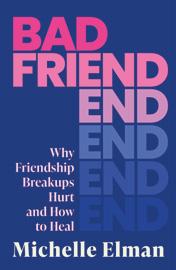
‘Bad
Friend: Why Friendship Breakups Hurt and How to Heal’ by Michelle Elman is out now (Renegade Books, £20)

I trust the process
Every challenge is an opportunity for growth
I am constantly evolving
I am capable of more than I can imagine
I am proud of how far I have come
I am worthy of a life filled with good things You cannot move forward, without learning to let go
My self-worth isn’t determined by the opinions of others
Sometimes a step back is actually course correction
Change is not the enemy

In the UK, around 30,000 women a year suffer post-traumatic stress after giving birth – but there is help at hand
Writing | Lydia Smith
After a 70-hour labour, with multiple medical complications, my son was born via emergency caesarean. Afterwards, I struggled with flashbacks, intense anxiety, guilt, and anger because it seemed like nobody understood how I felt at the time.
I now know that post-traumatic stress disorder (PTSD) after giving birth affects around 30,000 women every year in the UK – and that this figure likely excludes many more who struggle in silence.
I was fortunate to access birth trauma therapy on the NHS, via my local perinatal mental health team. Although it was daunting at first, therapy has helped me cope with the symptoms of PTSD.
I rarely have intrusive flashbacks, and I can now talk about my experience without feeling like I’m back in the hospital ward, going through it all again.
Different therapists have their own approaches to counselling – and often, this depends on the needs of the client. But, here’s what you might expect if you decide to explore birth trauma therapy.
Before I began talking about my birth experience, my therapist took time to get to know me. She encouraged me to talk about my job, life, and background, so she could understand my needs, and build a trusting relationship. There was no pressure to
immediately start talking about my traumatic experience – she recognised that getting to that would take time.
“When working with someone who has experienced birth trauma, I would start by building trust between myself and the client,” says psychotherapist Laura Wood. “It is important that the client feels safe, knows they will not be judged, and that they have confidence in the therapist’s skills. The client can choose when they start to talk about their birth or pregnancy, and they can talk at the speed that they’re comfortable with.”
While therapists have different approaches, trust is recognised as crucial to all therapies. Numerous studies over the years have >>>


suggested that being in a safe and secure environment, with plenty of validation and support, can help promote trauma recovery, including 2022 research in Psychiatric Quarterly.
Processing trauma is difficult, but necessary. In my weekly sessions, my therapist encouraged me to talk about my birth experience in
as much detail as I could manage. We worked through the events slowly and methodically, talking about what happened and how I felt at the time. The more I talked about it, the less intense the emotions felt.
“The client will go over their traumatic experience of birth, sometimes repeatedly and from different angles,” Laura explains. “Common emotions that come up are helplessness, anger,

frustration, and disappointment. While a client is telling a story of something traumatic, it’s important to pause and allow them to focus on what happens in their body when they remember the traumatic event. The emotions that were too painful to be experienced in that traumatic moment may come up to the surface at this point.”
It was difficult, but acknowledging these emotions
helped to lessen their hold on me. After each session, my therapist made sure to ‘ground’ me, so I wasn’t left feeling too raw. She did this by asking me to name five things I could see, four things I could touch, three things I could hear, two things I could smell, and one I could taste. This exercise brought me back to my immediate surroundings, as talking about a traumatic experience can make you feel like you’re reliving it. It also helps to calm your fight-or-flight response which is often activated when talking about trauma.
Another important aspect of birth trauma therapy is feeling validated. When I was in labour, I felt like my pain was being dismissed by the doctors and midwives. Specifically, I remember being told that “everyone asks for a C-section” after requesting one – and feeling angry when I later needed an emergency caesarean.
My therapist encouraged me to open up about my feelings of anger. She also helped me acknowledge that I hadn’t done anything wrong. “It is important that the therapist validates the trauma that the client has experienced,” says Laura. “Validation requires therapists to understand the complex social and political reasons why birth trauma occurs, so the client is seen and understood in context.”
For example, PTSD can occur as a result of unexpected medical interventions, birth injuries, and pain, as well as systemic problems like an understaffed or underfunded maternity ward.
My birth PTSD therapy journey came to an end after six months of therapy sessions. I was happier, the flashbacks were less common, and I felt like I could live my life normally again. When my therapist asked if I could go back to the hospital without feeling distressed, I truthfully said yes. While therapy was lifechanging, it was very difficult. I often dreaded the sessions and, afterwards, I felt emotionally drained. As you heal from trauma, it’s essential to look after yourself. Give yourself time after each session to switch off, instead of going straight back to work or to your baby. Be kind to yourself, and do things that you enjoy. And, importantly, talk to loved ones about how you’re feeling – don’t keep all those difficult emotions to yourself.
If you’re struggling with postnatal PTSD, talk to your doctor or health visitor. You can also self-refer for talking therapy on the NHS, although it may not be specifically tailored to birth trauma. You can also find private therapists via the Birth Trauma Association (birthtraumaassociation.org).
A step-by-step guide to unearthing, and then living by, your core values
Writing | Lydia Smith Illustrating | Rosan Magar
Whether we realise it or not, we all have personal values that are meaningful to us. These are abstract ideals that affect who we’re friends with, our career choices, and even where we live. While we’re not always conscious of them, these core values often act as our internal compass.
“Personal values are the core beliefs that guide our decisions, behaviours, and sense of purpose,” says Dr Elena Touroni, a consultant psychologist and co-
founder of the Chelsea Psychology Clinic. “They shape how we interact with the world, and what we prioritise. If honesty is a key value, you’re likely to seek open communication, and struggle in environments where deceit is common.”
Although they are similar concepts, beliefs are things you perceive to be true, but values are the principles you see as being worthy and important to live by. “Knowing your values helps you make decisions that align with
who you are,” says Dr Touroni. “It allows you to set healthy boundaries. If you value respect, you might distance yourself from a friend who belittles you. Living by your values creates a sense of integrity and self-respect.”
Living in line with your values is a powerful tool that can support your mental health, with a 2024 study, published in Personality and Individual Differences, noting
the benefits of this for mental wellbeing. Plus, a 2023 study in the Journal of Contextual Behavioural Science reported lower depression and anxiety in those who actively lived according to their values.
“When you live in line with your values, life feels more meaningful, and decision-making becomes easier,” says Dr Touroni. “It reduces stress, as you’re not constantly second-guessing yourself. When your actions reflect your beliefs, you feel more confident and grounded.”
Although values that promote higher subjective wellbeing are considered healthy, as noted in the 2018 Handbook of Wellbeing, it’s important to find balance. While ambition is generally positive, an excessive focus on success can easily lead to anxiety.
Consider what’s important to you Dr Touroni recommends reflecting on what truly matters to you. Think about a time when you felt grateful – e.g. if this was when a friend supported you through a difficulty, it could suggest that dependability is a strong value for you.
Ask yourself if there is anything you would like to focus on. “Think about what makes you feel fulfilled,” Dr Touroni says.
Try a step-by-step approach
Helen Unwin, a life, confidence and ADHD coach, recommends following her step-by-step process. First, choose the top 10 values that you appreciate in yourself and others. “Don’t take too long, just go with your gut,” she says.
Examples might include:
• Honesty: Being truthful with other people.
• Compassion: Showing empathy.
• Responsibility: Taking ownership of your actions.
• Authenticity: Being yourself as openly as possible.
• Learning: Finding new things.
• Freedom: The ability to make choices.
• Strength: Navigating obstacles.
• Adventure: Enjoying new experiences.
Describe your values
Whittle this down to your top five, and put these in order of priority. Then describe exactly what each one means to you in a sentence. If ‘wellbeing’ is important to you, you could write: ‘Prioritising mental health at work.’ Next, write an action that would be the opposite of your value, and describe it. This will help you recognise times when you may have engaged in behaviours that don’t align with your values. For example:
• Personal value: Wellbeing
• Description: Prioritising mental health at work.
• Opposite: Taking on more work that I have capacity for.
Carry out an audit
To work out if you’re living according to your values, Helen suggests carrying out an audit. Rate each of your five values out of 10 to signify how successfully you feel you’re currently living in alignment with it. Then, consider how living at a 10 for each value would change your life. For example, showing yourself more
compassion might lead to a more relaxed nervous system, build your confidence on first dates, or make you happier.
Keep track of your values
Keeping a list of your values somewhere visible – like on your fridge, phone, or mirror – can remind you of what’s important to you. You could also share it with a partner or a close friend, who can provide accountability, and help you make decisions that align with your values.
Make small changes
Small changes can help you live more authentically to your values. If there are things holding you back, you might want to explore them with a therapist or coach. Keeping a journal can also help you identify where you could change your behaviour to complement your values. “Check in with yourself regularly – are you living in a way that honours these values?” asks Dr Touroni. “If not, adjust accordingly.”
Remember, your values can change in life as experiences shape you. So, taking time to check-in regularly, and rediscover your core principles, could set you on a true path to success.

Connect via the Counselling Directory.

Live in the sunshine, swim in the sea, drink in the wild air
M a s t e r c l a s s
We’re getting up close and personal with empathy, its benefits, and how to cultivate more of it
Writing | Rosie Cappuccino
In any conversation about strengthening relationships, building community, or lessening shame, often one of the first words to arise is empathy. But what actually is empathy –and how can we cultivate it so it becomes more abundant in our lives, and the lives of people we encounter?
‘Empathy’ captures a myriad of things, which can make it challenging to describe accurately. However it can be summed up as the ability to recognise someone else’s feelings or experiences from their frame of reference – rather than from your own viewpoint – and using this insight to better understand what it’s like to be in their situation. Empathy is also sometimes thought of as being able to feel how another person is feeling, while staying aware that you are a separate person. Integrative counsellor and psychotherapist Nadia DiLuzio, describes being empathetic as
“stepping into someone else’s world for a moment. Suspending our judgement, our viewpoint, our experiences, in order to bear witness to theirs.”
It’s often considered that empathy can be broken down into three types:
• Affective: recognising a person’s emotional response or state (e.g. feeling distress over someone else’s wellbeing)
• Somatic: physical reactions to another’s experiences (e.g. feeling nervous, with a racing pulse, on another’s behalf)
• Cognitive: understanding what’s going through someone else’s mind, or their thought process, in a situation.
And while often associated with compassion and sympathy, the notable difference is that empathy is a more active response – the awareness of, and sensitivity to, others’ internal states to the point that these feelings might take on a resonance in your own body and mind. By contrast, sympathy is more a passive feeling, usually

related to concern for someone, but without entering into a more nuanced awareness of, or deeper connection with, another person’s inner world.
As Nadia points out, empathy is “a trait that evolved to help early humans survive and thrive in complex social environments, through cooperation and mutual support”, noting its ability to strengthen social bonds and group survival. “In today’s world, empathy can underpin social justice, promote inclusion, improve communication, develop better leadership, and support our emotional and mental health.” >>>

Imagining ourselves into someone else’s position, and then using their frame of reference to more closely understand their experiences, fosters trust and open communication, as well as supporting emotional regulation. After all, many of us know how it feels to share something important or difficult, and be met with a lack of empathy. Without empathy, the conversation may shut down, and it can be hard to open ourselves up to seek support. We may, understandably, be left with feelings like discomfort, isolation, or shame.
On the other hand, when we’re met with an empathetic response it’s fertile ground for honesty and trust. The conversation tends to open up – either in the moment or in the future. If empathy could speak it would say: ‘Tell me more, I want to understand more fully.’ This added dynamic in our personal interactions can allow us to engage in more supportive discussions, find compromise, conflict resolution, and recognise another person’s point of view. And science backs up the benefits of being more empathetic. A 2021 study in Healthcare (Basel) found that empathy increased engagement in volunteering, which, in turn, improved participants’ mental health – highlighting the powerful cycle of giving back, and how empathy benefits both ourselves, and society. Plus, studies, including 2020 research in the International Journal of Environmental Research and Public Health, reported that “aspects of empathy, such as others’
perspective-taking and personal distress for others’ difficulties” saw improvements in both psychological and subjective wellbeing.
How can we develop empathy?
“Empathy can be instinctive,” Nadia notes, for some people – for example, as a result of life experiences that made it necessary to attune to others’ emotional states. However, it can also be developed.
Often, the first step is to think of empathy as a skill, rather than a fixed personality trait. Like any other talent, such as riding a bike or watercolour painting, empathy can be honed with practice. As
with all skills though, we each have different starting points, and do them in slightly different ways, so try not to judge yourself or deem one empathetic response as ‘better’ than another.
yourself
Practising empathy, as Nadia reminds us, requires “putting ourselves to one side for a moment”. This gives space for the “possibility of other thoughts, feelings and experiences that are not our own”.
Creating space for others’ emotional landscapes requires an acceptance of, and respect for, difference. Two people can experience the same situation in a variety of ways, and that’s a

beautiful, fascinating part of what it means to be human.
To make space for someone when they are speaking, notice the urge to jump into their story with your own interpretations or anecdotes. These urges often precede phrases like: ‘That happened to me too,’ or ‘Let me tell you about when…’
By noticing your urge, you have the choice to withhold your experiences or opinions until the speaker has fully expressed themselves – or save them for another time. While relaying shared experiences can be helpful at certain times, sometimes it can make the conversation partner censor or tame their narrative, to make it sit more comfortably alongside yours.
‘Listen to hear, not respond’ Nadia advises ‘listening to hear, not respond’, even though this can feel counterintuitive, because our natural instinct is to start formulating a response.
Focus on the words the other person is saying, instead of rehearsing what you might reply. Rather than seeing silence as the

Nadia DiLuzio is an integrative counsellor and psychotherapist. Find her profile on the Counselling Directory.
proverbial ‘tumbleweed’, view it as an opportunity to gather your thoughts in response to what the speaker has just shared. Practise this a few times to get more comfortable with silences – and not needing to fill them.
If you find yourself interrupting, try to be self-compassionate – it often originates from a desire to communicate interest. However, cutting in tends to stop the flow of the speaker, so explore ways to calm your urge to interrupt. Some people find it helpful to press their hand to their chin, or the side of their face.
Read body language, too
It’s not just verbal clues that can help us connect, but developing a more conscious awareness of a person’s body language or other non-verbal cues. You might get a sense of what a person is really feeling or thinking based on what’s left unsaid.
Sit with discomfort
Sometimes, people share things that evoke discomfort. This could be an aspect of their identity or a narrative which feels challenging to relate to. By recognising that this process is not always easy, we can develop the courage to get closer to topics that sit outside our comfort zone. It’s OK not to know something, and we all have topics that make us feel uneasy at times.
When you manage to stay present in new territory, acknowledge the win, but remember that it’s OK to gently pause a conversation that is emotionally difficult or triggering, seeking support where needed.
Questions instead of answers
Empathy isn’t about having answers, but about being open to possibilities – for how the other person might feel, and in responding flexibly to them. If they’re comfortable, ask a few questions, like: ‘Would you like to talk more about that?’ or ‘What was that moment like for you?’
Let complexity breathe
If someone shares complex feelings, know that your role is not to translate these into something straightforward. An empathetic response doesn’t try to change how someone feels, but instead, lets them express it outwardly. Empathy requires courage – to embrace silence, the unfamiliar, or contradictions. So, empathise with yourself as you develop this nuanced skill with others.
Rosie Cappuccino writes and speaks about her life with BPD, and is the author of ‘Talking About BPD: A Stigma-Free Guide to Living a Calmer, Happier Life with Borderline Personality Disorder’. Visit her blog talkingaboutbpd.co.uk


Can ultimatums ever really work, or are they simply a toxic relationship tool? We speak to a therapist to uncover the truth
Writing | Bonnie Evie Gifford
Nobody likes to feel backed into a corner – or like they are reliving the same situation over, and over, and over again. Ultimatums can feel like our final resort, but really, are they ever helpful?
Whether it’s an idea from a Netflix reality show, or advice from well-intentioned friends, many relationship issues can result in feeling like an ultimatum is the only option. Perhaps little things have built up over time, like feeling you’re always late because of your partner, or you’re the one carrying all the emotional labour. Or maybe something big happened to rock your foundations, like infidelity. If you feel like you’ve reached breaking point and something has to change, you might be tempted to offer an ultimatum – something
that can have more effects than you may realise.
“We often default to ultimatums when our limbic alarm systems (fight-or-flight) override our prefrontal cortex’s capacity for nuanced negotiation. Simply put, this means we feel emotionally unsafe in our relationships,” says Tina Chummun, a UKCPaccredited therapist, while explaining why we resort to ultimatums.
“Ultimatums can feel like implementing emotional seat belts, temporarily anchoring us when our life context/situation or career feels stalled, our hormones tug at our ticking-clock fears, and our expectations crash against our relationship realities. Yet that black-and-white fixed thinking, which appears demanding, often speaks more about our inner
panic than feelings about our true partnership.”
Ultimatums come from a place of desperation. Something has to give. But are ultimatums really the best way to make lasting changes?
An ultimatum is essentially a final resort: if your demand isn’t met within a time limit, there will be consequences. A boundary, on the other hand, is about communicating your needs and limits clearly, without trying to control what your partner is doing. Think of it this way: an ultimatum is the final word on a topic where you want to change your partner’s behaviour, whereas setting boundaries is more of a starting point for further discussion and change.




For example, saying something like: “If you don’t stop talking to your ex, I’m breaking up with you” would be an ultimatum – and could risk sounding combative. The same issue could be reframed to set and clarify boundaries without issuing a demand. Tina recommends opening up the conversation and finding healthy boundaries together. “Try: ‘I notice I feel really anxious and disconnected when I don’t know how often you communicate with your ex. It would help me to understand you more if we agreed on sharing our social interactions, so I can feel safe and secure. Could we find some time and space to discuss what
feels respectful to both of us?’ This invites collaboration, honours your emotional attunement, and leverages safe-space two-way dialogue instead of an all-ornothing demand.”
Can ultimatums ever be healthy in a relationship?
We know that there’s rarely one answer that works across all relationships, but can ultimatums ever really be healthy?
“On small-scale examples – say, for instance, divvying up chores – an ultimatum might spark immediate compliance, satisfying our dopaminergic reward loop. For a much more intense example like infidelity, it’s akin to placing
Ultimatums can feel like implementing emotional seat belts, temporarily anchoring us when our expectations crash against our relationship realities
a Band-Aid on a bleeding artery,”
Tina explains. “Yes, you might secure a promise on the spot from your partner, for them fearing losing you, and you’ll also store resentment for placing them under immense pressure once the moment has passed. In Netflix’s The Ultimatum: Marry or Move
On, many couples secure a ‘yes’, yet months later, the simmering resentment surfaces. So, while ultimatums can trigger short-term change, they seldom cultivate lasting emotional attunement.” While ultimatums can come from a place of desperation, it’s important to remember that, sometimes, they can become weaponised. Constantly issuing >>>



ultimatums can be damaging to a relationship. For those on the receiving end, it can undermine how secure they feel in their relationship. Over time, repeated threats can cause a breakdown in feelings of trust and safety.
“Repeated threats of abandonment weaponise attachment insecurities, and corrode trust, and neurological safety,” Tina explains. “When you say ‘Stop speaking to your ex or else’ over and over again, you’re training your partner’s fear centre. Over time, such tactics can shift neural pathways toward hypervigilance, erode self-worth, and usher in emotional abuse – especially if wielded during
vulnerable life transitions when our threat detection is already on high alert.”
How can couples communicate their needs and wants more effectively?
Learning new ways to communicate with our partners can feel daunting, especially when we feel like we’re already trying and aren’t being heard. But there are steps to improve things:
• Be open and clear. It can be easy to get lost in the moment, or to feel like saying what we really need to say is tough. Ensuring you communicate how you are feeling, what actions and behaviours are affecting you, along with the impact, can be a great starting point to open up new dialogue.
• Set boundaries. Boundaries can help us to feel happier and more secure both in ourselves and within our relationships, while communicating clearly with our partners about what matters most to us.
• Save ultimatums as a last resort. If nothing else works, ultimatums can – occasionally – help, depending on the situation.
• Creating space to check-in each week together about your


Tina Chummun is an accredited psychotherapist and trauma specialist. Connect with her on the Counselling Directory.
relationship can be one helpful ritual, Tina recommends, ensuring you focus on both the good (things that bring joy) and the not so good (things you may be worried or upset about). “If it feels too difficult to speak to one another about this, how about writing it down in a journal? Neuroscience shows regular communications surrounding emotional attunement strengthens our prefrontal-amygdala connectivity, reducing reactive ultimatums.”
Incorporating a check-in as part of your regular week can help to create a new tradition moving forward that works for both of you, while strengthening your relationship. “It’s about acknowledging where you both are emotionally in your relationship, accepting each other at the pace that you are each at, and communicating that so that you are both validated with where you both are at, while agreeing to take actions to move forward in your relationship,” Tina adds. Relearning how to communicate together can be a challenge, but once you start establishing new routines and boundaries to help support and guide the conversation, it can start feeling like you are on the same page. Soon, you’ll feel ready to start making decisions together before things feel out of control.
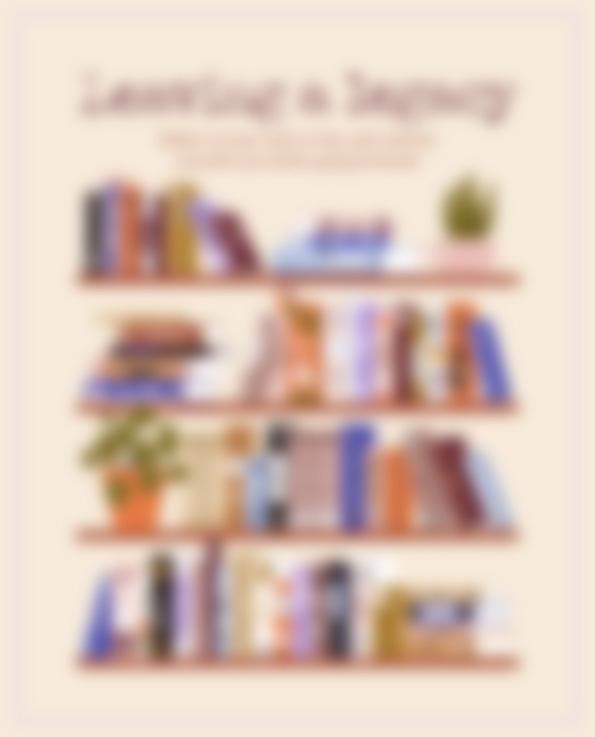
Looking for support with your mental health?
Here are some places that can help:
If you are in crisis and are concerned for your own safety, call 999 or go to A&E
Call Samaritans on 116 123 or email them at jo@samaritans.org
SANEline
SANEline offers support and information from 4pm–10pm: 0300 304 7000
Mind
Mind offers advice Mon–Fri 9am–6pm, except bank holidays: 0300 123 3393. Or email: info@mind.org.uk
Switchboard
Switchboard is a line for LGBTQIA+ support. Open from 10am–10pm: 0800 0119 100. Or web chat: switchboard.lgbt

• Pass me on to a friend who might appreciate some articles.
• Get crafty and use me for a vision board or collage.
• Keep me on a coffee table to pick up when you need a boost.
• Remember I’m 100% recyclable, so pop me in your recycling bin.
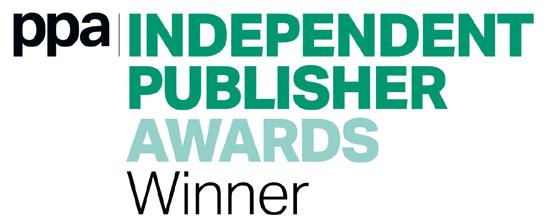
MANAGING MENOPAUSE
For news, information, and free resources, visit menopausesupport.co.uk
OCD SUPPORT
Visit ocdaction.org.uk or call the OCD Action helpline on 0300 636 5478. Lines are open Mon–Fri 9.30am–8pm.
p45 ALCOHOLICS ANONYMOUS
Call the helpline on 0800 917 7650 or visit alcoholics-anonymous.org.uk to find a local meeting. p25 p30

Our two-for-one tree commitment is made of two parts. Firstly, we source all our paper from FSC® certified sources. The FSC® label guarantees that the trees harvested are replaced, or allowed to regenerate naturally. Secondly, we will ensure an additional tree is planted for each one used, by making a suitable donation to a forestry charity. Happiful is a brand of Memiah Limited. The opinions, views and values expressed in Happiful are those of the authors of that content and do not necessarily represent our opinions, views or values. Nothing in the magazine constitutes advice on which you should rely. It is provided for general information purposes only. We work hard to achieve the highest possible editorial standards, however if you would like to pass on your feedback or have a complaint about Happiful, please email us at feedback@happiful.com. We do not accept liability for products and/or services offered by third parties. Memiah Limited is a private company limited by shares and registered in England and Wales with company number 05489185 and VAT number GB 920805837. Our registered office address is Building B, Riverside Way, Camberley, Surrey, GU15 3YL.
